Microgreens are not just a trend, but also a very beneficial product! Tender young sprouts contain more vitamins and essential elements for the human body than the vegetables themselves.
You can enjoy fresh sprouts with your family all year round, regardless of the season. By adding just a handful of sprouts to a salad or sandwich, you’ll not only give them a restaurant-like appearance and unique taste, but also add extra nutritional value. This greenery is also becoming very popular around the world, and growing it is a highly profitable business.
In this article, we will explain the benefits of microgreens, which crops can be grown, and provide their detailed descriptions.
The Benefits of Microgreens for the Body
Microgreens are a true modern superfood. Almost any crop can be grown as microgreens.
These young plants are not exposed to environmental influences, which means they retain the maximum amount of nutrients.
Scientists have proven that microgreens contain 100 times more enzymes than raw vegetables, as they are in an active growth phase.
During the first 10 days of life, microgreens do not have time to accumulate harmful substances from the atmosphere and grow in environmentally clean conditions.
Microgreens are very rich in beta-carotene. Its beneficial properties are numerous, but the main one is that it blocks ultraviolet radiation, protecting our skin, hair, and nails from the harmful effects of the environment.
These green sprouts are full of plant-based protein, vitamins (C, B, K, E), carotenoids, minerals, and other valuable elements (potassium, calcium, phosphorus, magnesium, iron, iodine, sulfur), as well as essential oils. Each of these components has a positive effect on the human body.
Folic acid is needed for the formation of new blood cells, which is especially important for women planning pregnancy. Vitamin C is the best antioxidant. Carotenoids support better immune function. Rutin prevents blood clots and has an anti-inflammatory effect. Chlorophyll is a well-known antioxidant with anti-tumor properties.
With regular consumption of microgreens, you can improve the functioning of the cardiovascular, digestive, nervous, reproductive, and endocrine systems. These miracle sprouts prolong youth, improve the condition of the skin, nails, and hair, and are a dietary food with minimal calories.
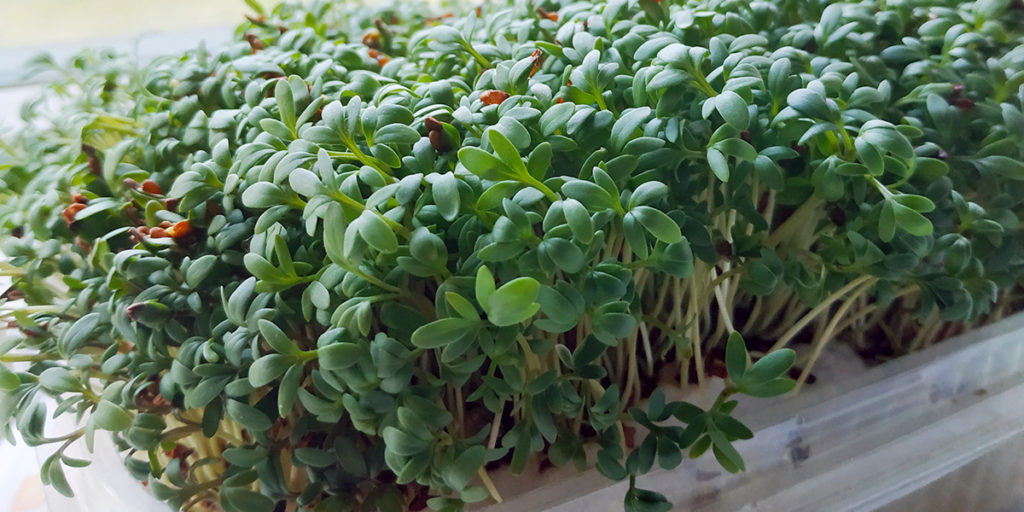
Which Seeds to Choose for Growing Microgreens
Almost all crops can be grown as microgreens: grains, legumes, and vegetables.
However, plants from the nightshade family (such as potatoes, tomatoes, eggplants, and peppers) are not suitable for this method, as their sprouts contain solanine—a toxic substance that can cause digestive issues. It’s also not recommended to grow cucurbit plants, as their microgreens tend to be bitter. Bean sprouts contain toxic substances that can cause poisoning.
Only ecologically clean microgreen seeds should be used for growing—those that have not been pre-treated with chemicals or that have been harvested manually.
Microgreens also vary greatly in taste. Their flavor resembles that of the mature plant, but is more delicate and aromatic. For those who enjoy a spicy note, mustard, onion, cilantro, and radish are great options. For those with a sweet tooth, sunflower, corn, amaranth, and peas are worth considering.
Which Crops Can Be Grown as Microgreens
We offer you a list of the most common crops grown as microgreens.
Adzuki (Red Vigna, Red Bean)
In Asia, adzuki beans are widely used in many dishes and desserts. This legume is very convenient for beginners, as it is easy to grow. The leaves are large and crispy, often used as a salad substitute.
Like soy and mung bean, adzuki is a legume from a temperate climate, requiring air temperatures of +25…+30°C for cultivation.
Adzuki contains a high level of protein, which is known to be beneficial for diabetes.
| Flavor | Rich, sweet, nutty |
| Color | Green leaves and stems |
| Pre-soaking | Да (6-8 часов) |
| Germination time | 3–5 days |
| Harvest time | 10–14 days |
Alfalfa
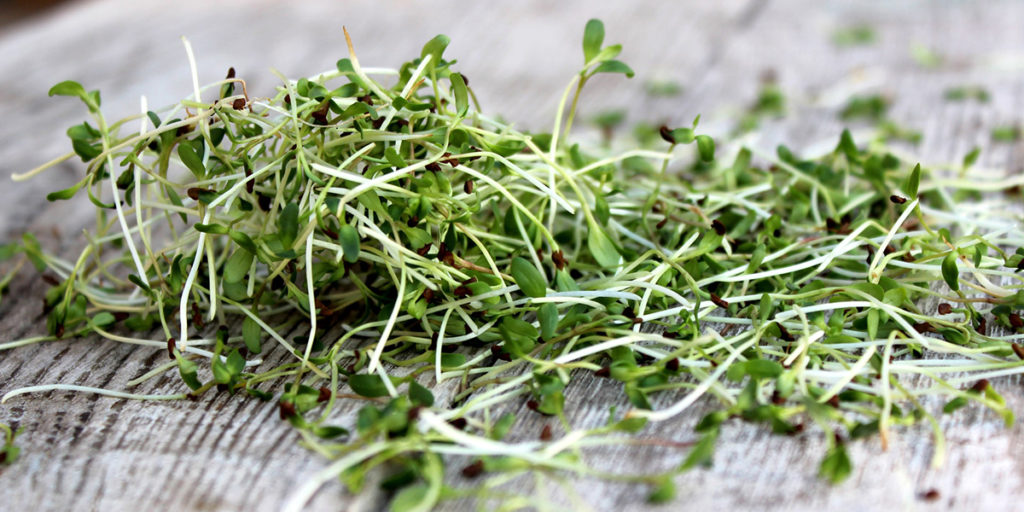
Crisp and fresh greens, like a just-picked cucumber from the garden. A fragrant addition to fish, eggs, salads, and appetizers.
Regular consumption of sprouts prevents the development of breast cancer, helps with diabetes, and minimizes menopause symptoms. Alfalfa microgreens are beneficial for people with iron deficiency. They also contain magnesium, phosphorus, calcium, and vitamins C, K, A, and E.
| Flavor | Mild, nutty, crunchy, pea-like |
| Color | Dark green leaves and stems |
| Pre-soaking | No/Yes (6–8 hours) |
| Germination time | 3–5 days |
| Harvest time | 5–7 days |
Amaranth
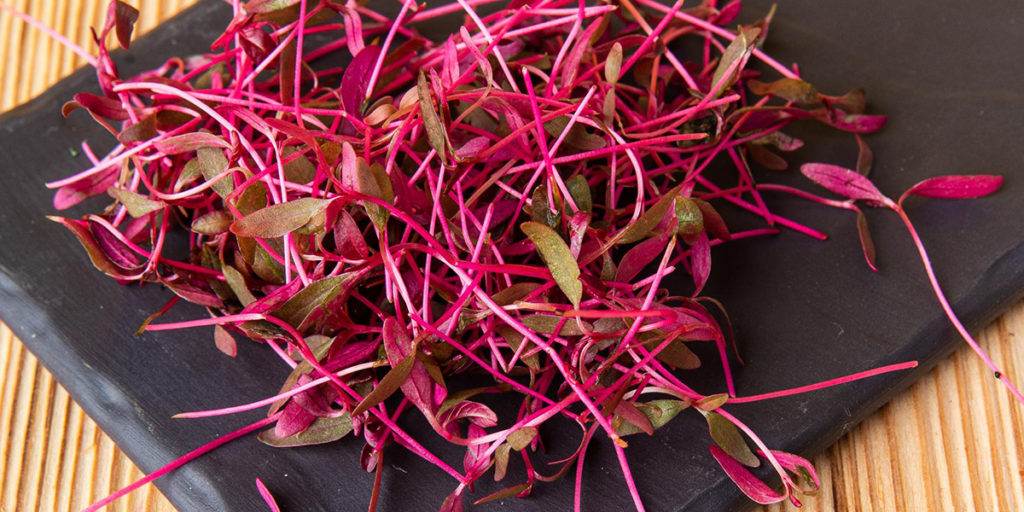
Greens with pink leaves that have a delicate flavor with a nutty aftertaste. Chefs like to use it for decoration because it has a bright red-pink color and a mild earthy taste that pairs well with both sweet and savory dishes. Perfect for making healthy smoothies.
However, it should be noted that amaranth is quite sensitive to light and grows a little slower. Therefore, the dark period should be 4–5 days for the plant to grow taller before exposing it to light.
Amaranth microgreens are rich in vitamins. They contain phytosterols, which have cholesterol-reducing properties and act as agents preventing cancer and cardiovascular diseases.
Also, amaranth microgreens contain complete protein with essential amino acids, unlike other sources. It is a powerful antioxidant, stimulates digestion, boosts immunity, reduces hair loss and graying, and improves vision.
| Flavor | Beet-like, earthy |
| Color | Bright reddish-pink stems, dark red leaves with a green tint |
| Pre-soaking | No/Yes (4–6 hours) |
| Germination time | 2–3 days |
| Harvest time | 7–10 days |
Anise
Anise microgreens are delicate and crunchy with a grassy and licorice-like aroma. They have a mild peppery taste with notes of mint, lemon, sage, and fennel, making them suitable for decorating appetizers and soups.
It should be noted that anise sprouts quickly and easily. When growing it, lighting should be turned on 2–3 days after the seeds begin to sprout.
It is widely used as a medicinal remedy. Anise helps with inflammation of the kidneys and bladder, and also removes sand from the urinary tract. It is useful for bloating, gastritis, flatulence, and other stomach disorders.
| Flavor | Mild licorice |
| Color | Light green leaves and stems |
| Pre-soaking | No |
| Germination time | 1–2 days |
| Harvest time | 7–8 days |
Arugula
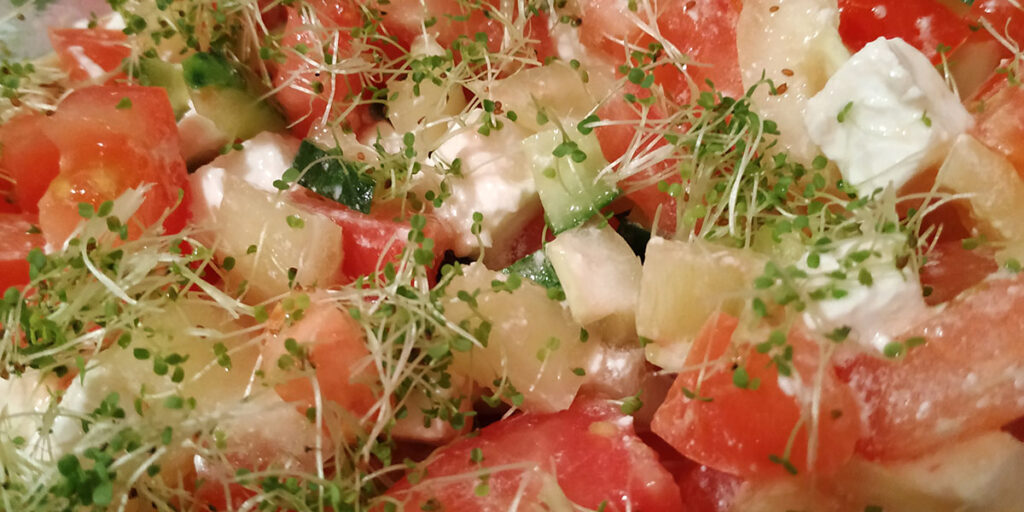
Arugula microgreens have a bitter taste, making them perfect for meat and fish dishes, especially as part of a sauce.
Arugula is quite easy to grow and sprouts in just a couple of days. When growing, just make sure the seeds are evenly spread and do not water them too heavily. Unlike others, arugula prefers an environment with minimal humidity.
Arugula microgreens are considered one of the healthiest natural products. It is an excellent source of folic acid, iron, copper, minerals, and vitamins. The greens are good for boosting immunity since they contain ascorbic acid.
Arugula improves bone and brain health, reduces the risk of cancer, has antioxidant properties, improves vision, and is a natural aphrodisiac.
| Flavor | Nutty, spicy |
| Color | Delicate green leaves and light purple stems |
| Pre-soaking | No/Yes (8–10 hours) |
| Germination time | 2–3 days |
| Harvest time | 7–10 days |
Asparagus
A slow-growing plant that requires quite a bit of time to grow. Therefore, pre-soak the seeds for 4–8 hours to break seed dormancy before sowing.
Asparagus is especially rich in potassium and vitamin A. They are essential for the health and beauty of skin, nails, and hair. Also, asparagus microgreens stimulate kidney function and have a positive effect on the intestines.
| Flavor | Herbaceous taste with a nutty hint |
| Color | Yellowish-green stems |
| Pre-soaking | Yes (4–8 hours) |
| Germination time | 7–10 days |
| Harvest time | 20–24 days |
Barley
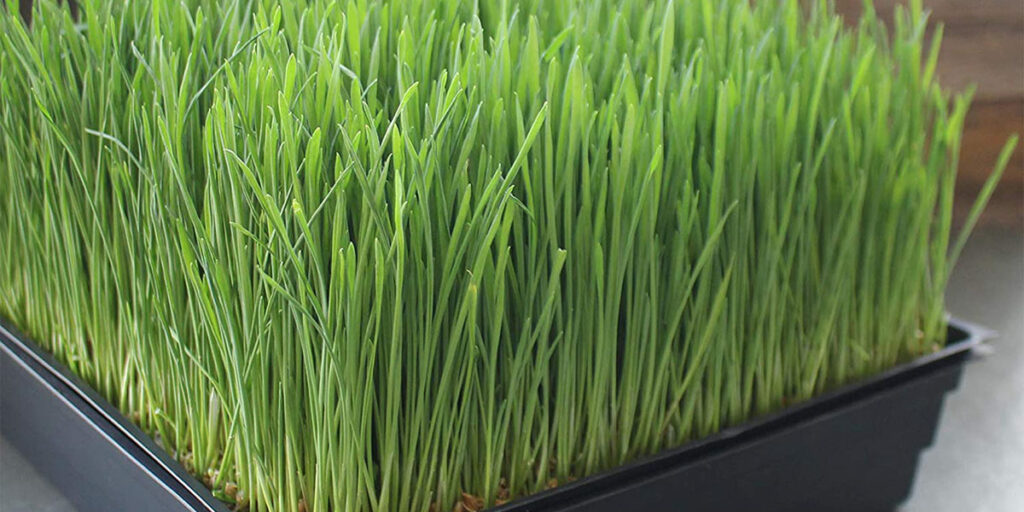
Young barley plants have an unusual earthy and grassy flavor, so they are not very popular. This is a pity because they have a high content of protein, dietary fiber, vitamin E, beta-carotene, and minerals. Consuming microgreens improves digestion, controls blood sugar levels (diabetes), and prevents heart disease and cancer.
Barley sprouts can be fried with spices and other vegetables, as well as added to fresh juices or healthy smoothies.
Also, sprouted barley is more often used as feed. Pets such as dogs, cats, and rabbits enjoy chewing fresh grass.
| Flavor | Mild, earthy, slightly grassy |
| Color | Bright green on the upper leaves and stems, yellowish and whitish on the lower parts |
| Pre-soaking | Yes |
| Germination time | 1–2 days |
| Harvest time | 7–9 days |
Basil
Another popular type of microgreens. There are many different varieties of basil that differ in color and flavor. Some flavors are spicy and sweet, while others resemble lemon and cinnamon. It pairs well with all dishes and is a great addition to salty cottage cheese and omelets.
A feature of basil is its sticky seeds. When they get wet, a sticky gel-like capsule forms around them. Its main function is to protect the seeds from adverse environmental conditions. Therefore, it is important to evenly distribute the seeds so they do not clump together in one place.
Basil microgreens contain carotene, ascorbic acid, B vitamins, and essential oils. It has a positive effect on digestive organs. The microgreens contain antioxidants that fight diseases, are an excellent anti-inflammatory agent, have antibacterial properties, and help combat stress and depression.
| Flavor | Intense, slightly sweet, spicy, sharp, and piquant |
| Color | Green or bright purple leaves, light green or light purple stems |
| Pre-soaking | No/Yes (2–4 hours) |
| Germination time | 2–3 days |
| Harvest time | 5–14 days |
Cвекла
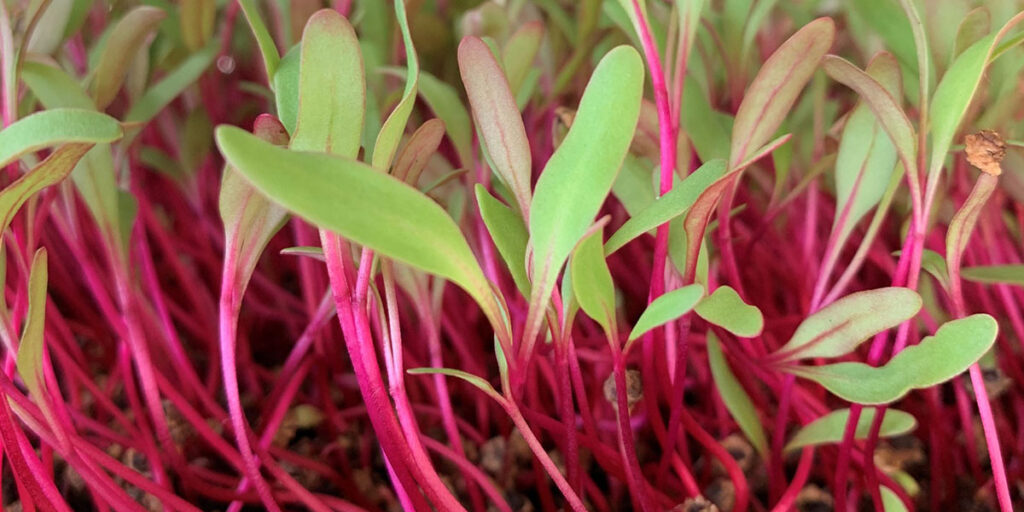
Juicy red shoots with dark green leaves make an excellent decoration for soups, salads, or sandwiches. They have a slightly sweet taste reminiscent of table beets. Growing them is quite easy, so beet is suitable even for beginners.
For better germination, seeds need to be soaked for 10 hours to trigger breaking dormancy. Red, yellow, and borscht beets can be grown as microgreens. For best results, supplemental lighting is recommended to be turned on 5–6 days after seed sprouting.
Beet microgreens are beneficial because they have a tonic effect on the body and strengthen immunity. Young shoots contain vitamins K, C, and E, as well as beta-carotene and lutein. They reduce the risk of heart disease and stroke, protect against lung and oral cancer, are good antioxidants, and enhance immune function.
| Flavor | Earthy, similar to beetroot but slightly sweeter |
| Color | Bright red or green on leaves and stems |
| Pre-soaking | No/Yes (8–12 hours) |
| Germination time | 2–3 days |
| Harvest time | 5–14 days |
Borage (cucumber herb)
A tasty herb that requires a little patience to sprout. This microgreen has the flavor and aroma of fresh cucumber. An excellent addition to fresh vegetable salads.
To speed up growth, it is recommended to soak the seeds in water for several hours. Supplemental lighting is recommended no earlier than 8 days after sowing the seeds.
Borage microgreens are recommended for fever, cough, and depression. It is a great source of energy that helps relieve stress, speed up metabolism, and even boost immunity. Borage is also used for “blood cleansing,” as a calming agent, and to stimulate sweating. Cucumber herb increases breast milk production.
| Flavor | Cucumber taste, slightly bitter |
| Color | Fat green leaves, light green stems |
| Pre-soaking | Yes (8 hours) |
| Germination time | 4–6 days |
| Harvest time | 10–15 days |
Broccoli
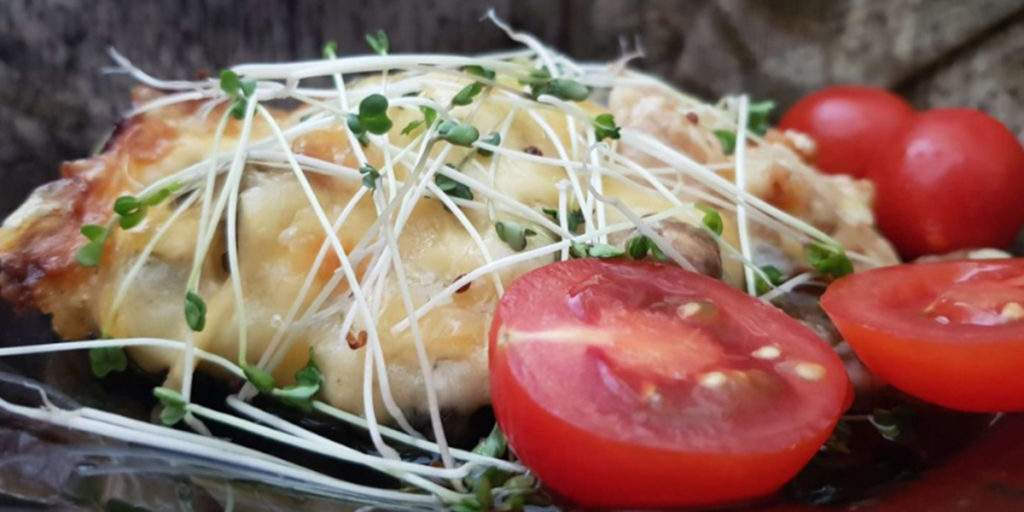
Broccoli sprouts are very crunchy with a mild flavor and a slight bitterness. Microgreens are great for vegetable salads, soups, and as a side dish for meat or fish.
Broccoli sprouts quite quickly and grows fast. You can harvest it on the 7th day after sowing. Additionally, broccoli does not require much moisture compared to other microgreens.
Broccoli sprouts contain vitamins A, C, and K, soluble fiber, indole-3-carbinol (I3C), sulfur, as well as a lot of protein and calcium.
This combination of nutrients improves bone health, digestion, and other important functions of the human body. It is an excellent remedy with health-promoting and anti-tumor properties.
| Flavor | Mild, crunchy, dense, with a slight bitterness |
| Color | Bright green leaves and slightly pinkish stems |
| Pre-soaking | No |
| Germination time | 1–2 days |
| Harvest time | 7–10 days |
Brussels Sprout
Brussels sprout microgreens are refined and aromatic. They grow quickly and are fairly easy to care for. However, they are less popular due to their bitter aftertaste, similar to broccoli.
To grow cabbage microgreens, you can use flax mats, hydroponics, or soil. After sowing, supplemental lighting is recommended no earlier than 3–4 days later.
Young Brussels sprout shoots are rich in vitamins K, C, and B6, as well as folic acid and minerals. Microgreens lower blood cholesterol, protect against cancer, support thyroid health, and more.
| Flavor | Mild Brussels sprout taste with bitterness |
| Color | Bright green leaves and pinkish-white stems |
| Pre-soaking | No/Yes (6–12 hours) |
| Germination time | 3–5 days |
| Harvest time | 4–7 days |
Buckwheat (common buckwheat)
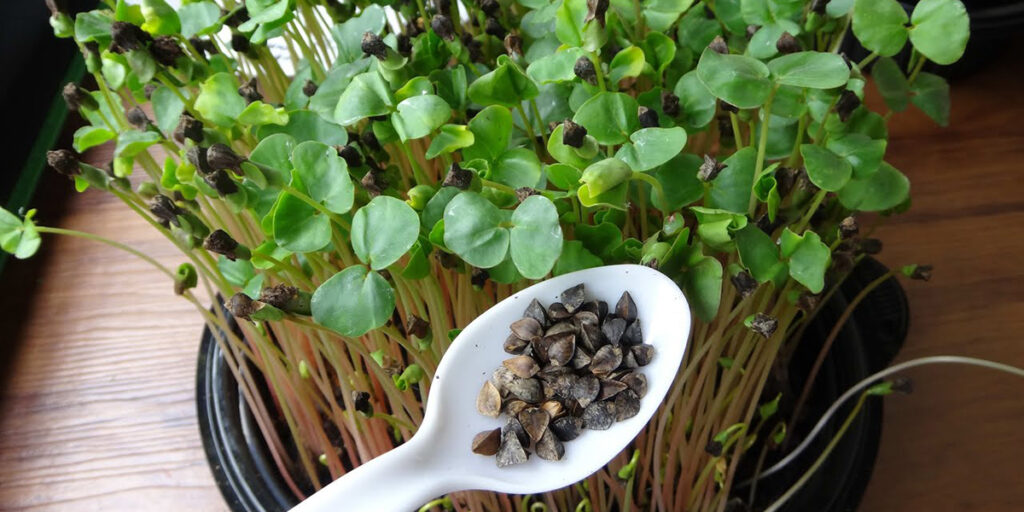
This is one of the most popular crops for sprouting among healthy lifestyle enthusiasts. Both regular and green buckwheat are used to grow microgreens. It’s added to vegetable smoothies, salads, and even used to make vegetarian cottage cheese from sprouted buckwheat.
Buckwheat grows quickly and does not require pre-soaking. However, for better germination, it can be soaked in water for 2 hours.
Regarding buckwheat microgreens, it should be noted that they contain a “toxic” substance called fagopyrin. Moderate consumption causes no problems, but excessive use may lead to skin sensitivity issues, including redness, swelling, irritation, and a burning sensation.
Nevertheless, buckwheat can boost immunity, improve the digestive tract, and replenish the body with nutrients. Microgreens help prevent cancer, leg swelling, atherosclerosis, and more.
| Flavor | Sharp, salad-like, slightly tangy |
| Color | Bright green leaves and white or light pink stems |
| Pre-soaking | Yes (2–4 hours) |
| Germination time | 2–3 days |
| Harvest time | 9–14 days |
Pak Choi
This is a type of Chinese cabbage that grows quickly and has high nutritional value. To get the most benefit, it should be consumed fresh in salads, sandwiches, smoothies, stews, on toast, or as a garnish for meat and fish dishes.
For quality sprouts, seeds are sown on flax mats, coconut substrates, or soil. Lighting is turned on 3–5 days after sowing.
The sprouts are several times more beneficial than the mature plant. Pak choi microgreens are rich in vitamins C, A, and E, as well as valuable beta-carotene, potassium, and more. Consuming this cabbage reduces the risk of cardiovascular disease, lowers cholesterol levels, prevents cancer, and more.
| Flavor | Mild, earthy, slightly sweet, juicy |
| Color | Green and purple leaves and pale lilac or pinkish-white stems (depending on the variety) |
| Pre-soaking | Yes |
| Germination time | 1–3 days |
| Harvest time | 8–10 days |
Carrot
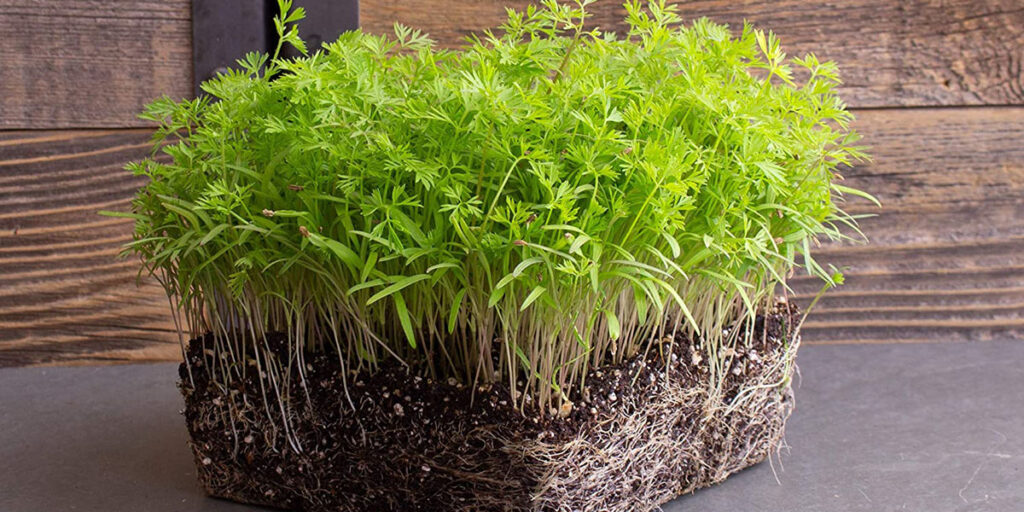
Yes, it can be sown not only as a root vegetable but also as a microgreen. The sprouts have a sweet, carrot-like flavor and a delicate aroma. Carrot microgreens are used as leafy greens and added to salads, rice, and fish, pairing wonderfully with sauces.
Microgreens can be grown in both soil and hydroponic mediums. In terms of flavor, while carrots are rich in nutrients, the taste is relatively mild.
Carrots are an excellent source of vitamin A, which helps prevent vision loss, and their fiber supports digestion. They also contain vitamin K, magnesium, calcium, folic acid, and potassium. Carrot sprouts contain five times more vitamin C than the root, along with a high amount of potassium and calcium.
| Flavor | Mild, earthy, and vegetal |
| Color | Bright yellowish-green leaves and stems |
| Pre-soaking | No |
| Germination time | 2–3 days |
| Harvest time | 8–14 days |
Cauliflower
Cauliflower microgreens have a high germination rate and grow quickly. Their sweet and slightly tangy broccoli-like flavor makes them a great addition to salad mixes. Unlike other brassicas, cauliflower microgreens develop strong, upright stems that don’t topple or tangle, making harvesting much easier.
They can be grown using hydroponics, coconut coir, flax mats, or peat. Pre-soaking the seeds is optional, and lighting should be introduced no earlier than 4–6 days after sowing.
Cauliflower is rich in glucoraphanin and a wide range of vitamins and minerals. Its young sprouts help reduce the risk of cancer and cardiovascular disease.
| Flavor | Mild, with a slight bitterness |
| Color | Bright green or purple leaves; white stems with purple tones (depending on variety) |
| Pre-soaking | No / Yes (6–12 hours) |
| Germination time | 3–5 days |
| Harvest time | 4–7 days |
Celery
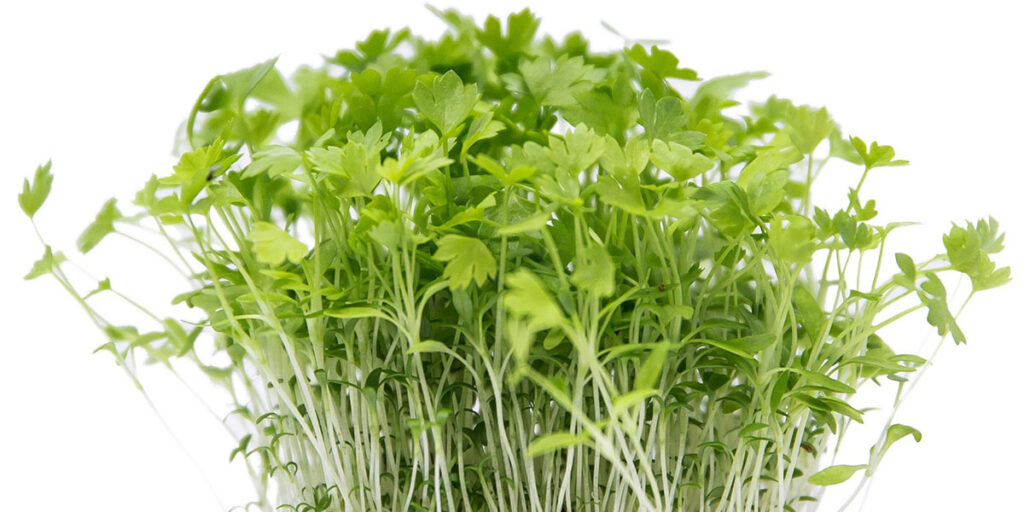
Celery microgreens have a sweet-salty, slightly spicy flavor. They are perfect for vinaigrettes, sandwiches, soups, and stews, adding a mild tang and aromatic note.
Growth is moderate, but germination is slow. Pre-soaking the seeds overnight (12–24 hours) is highly recommended to accelerate sprouting. Without soaking, germination can take significantly longer. Supplemental lighting should be introduced 2–3 days after the seeds sprout.
Celery microgreens contain more calcium, potassium, and vitamin C than mature stalks and roots. They are also rich in vitamins A, B, C, and E, dietary fiber, calcium, iron, magnesium, phosphorus, potassium, zinc, chlorophyll, amino acids, and antioxidants.
| Flavor | Mild celery flavor with a sharp, distinctive aroma |
| Color | Bright green leaves and stems |
| Pre-soaking | Yes (12–24 hours) |
| Germination time | 5–7 days |
| Harvest time | 14–21 days |
Celosia
An unexpected yet viable type of microgreen, celosia surprises with its stunning appearance and mild, earthy taste.
Although celosia is most commonly grown as an ornamental plant, many varieties have long been used in traditional cuisines. The young shoots are not only beautiful but also edible and nutritious.
| Flavor | Mild and earthy, similar to spinach |
| Color | Green stems and leaves with a light reddish tint |
| Pre-soaking | No |
| Germination time | 2–3 days |
| Harvest time | 8–12 days |
Chard
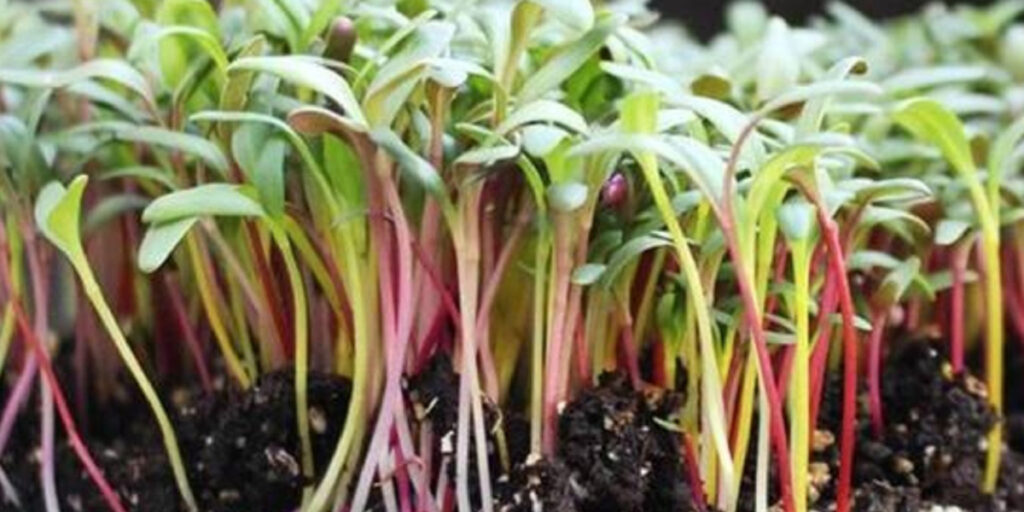
These vibrant microgreens are easily recognized by their raspberry-red stems and bright green leaves with a sweet, earthy beet-like flavor. Thanks to their striking appearance, Swiss chard microgreens are among the top choices for decorating gourmet dishes.One common drawback is that seed husks often remain on the leaves and must be removed.
To avoid this, you can sow the seeds under a dense layer of soil, then cover with loose soil, and finally add another thick layer. This method also works well for beet microgreens. As with beets, the blackout period should last 4–5 days after sowing.
Regular consumption of Swiss chard microgreens supports the nervous and digestive systems, strengthens blood vessels, and improves the health of hair, nails, and teeth. Chard also contains betalains, which aid in detoxification by activating and processing harmful toxins in the body.
| Flavor | Sweet, earthy, beet-like |
| Color | Green leaves with yellow, pink, red, or whitish stems (depending on the variety) |
| Pre-soaking | Yes (8–12 hours) |
| Germination time | 1–2 days |
| Harvest time | 8–10 days |
Chervil
An aromatic plant grown not only for culinary but also for medicinal purposes. Chervil microgreens have a spicy taste and an anise aroma. They perfectly complement sauces, soups, egg dishes, potatoes, fish, and poultry. The sprouts are thin and elongated.
Chervil microgreens can be harvested on the 12th day; many people prefer to wait a little longer until the true leaves appear to get a more intense aroma.
| Flavor | Mild, delicate taste of parsley and licorice |
| Color | Bright green leaves, whitish-greenish stems with a slight pink hue |
| Pre-soaking | No |
| Germination time | 2–4 days |
| Harvest time | 16–22 days |
Chia
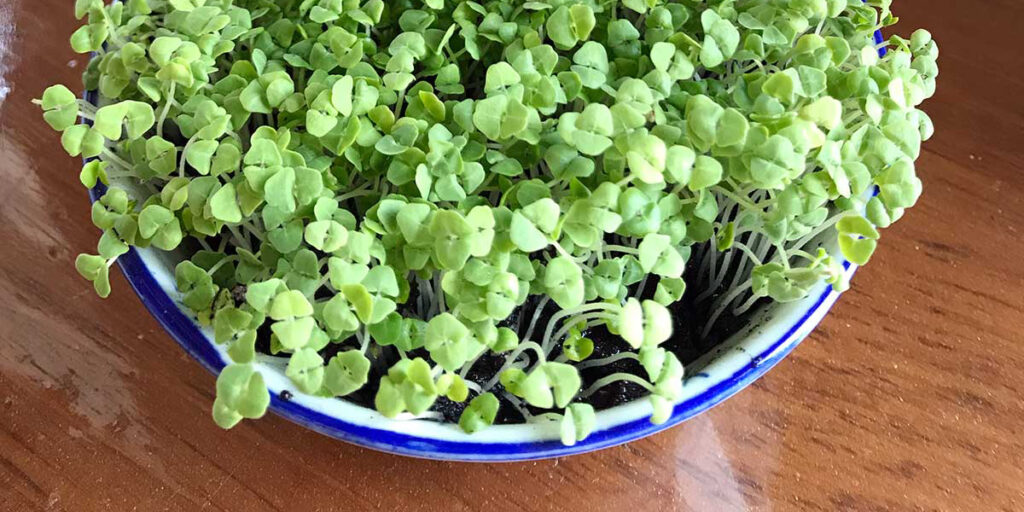
Favorite herb for those who follow a healthy diet and fight excess weight. Like basil and flax, chia seeds become covered with a gelatinous mucous membrane when wet. Chia can be grown in soil and other substrates used for microgreens.
Chia has a slightly bitter and minty taste. The sprouts contain many nutrients that are beneficial for digestion and in the fight against diabetes.
| Flavor | Sharp, slightly bitter and minty |
| Color | Green leaves and greenish-white stems |
| Pre-soaking | No |
| Germination time | 1–2 days |
| Harvest time | 10–12 days |
Chickpea
Chickpea is another easy-to-grow type of microgreen. The sprouts taste like young nuts, which children like. They are consumed as a separate dish or added to salads. Chickpea grows quickly in height and does not require frequent watering or shading.
It should be noted that the pre-soaking time should not be too long — no more than a couple of hours. This is because chickpea seeds are very sensitive to moisture and become mealy if soaked excessively.
Chickpea microgreens are an excellent prevention for colds, help reduce weight, and lower blood cholesterol levels. Chickpeas have a high content of protein, dietary fiber, folic acid, and vitamins A, C, K, and B6. Consumption improves digestion, strengthens heart health, regulates main body functions, etc.
| Flavor | Sweet, nutty taste |
| Color | Bright green leaves and pale green stems |
| Pre-soaking | Yes (2 hours) |
| Germination time | 8–10 days |
| Harvest time | 10–14 days |
Chicory
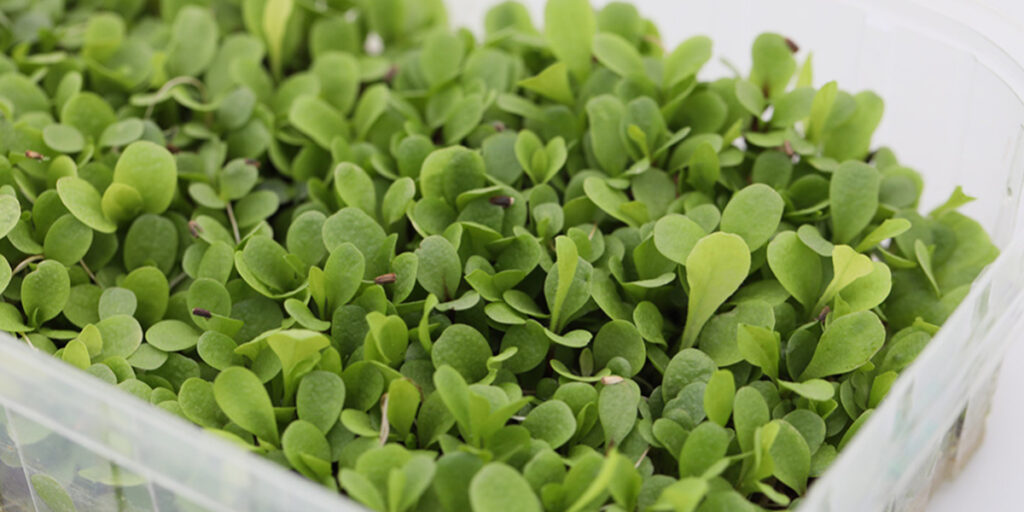
Chicory microgreens are not very popular but worth attention. These large-leaf sprouts have a slightly bitter aftertaste, so they are most often used in salad mixes.
Chicory leaves are rich in vitamin A and β-carotene, lutein and zeaxanthin, vitamins K and C. Chicory microgreens also contain folic acid, pyridoxine (vitamin B6), thiamine (vitamin B1), and niacin (B3).
| Flavor | Earthy, bitter aftertaste |
| Color | Yellowish-green leaves and green stems |
| Pre-soaking | No |
| Germination time | 3–5 days |
| Harvest time | 16–24 days |
Chives
Elegant microgreens with black seeds on the tips, having a pleasant smell and onion flavor. Perfect for appetizers.
They can be grown both in soil and in hydroponic systems. Germination takes one to two weeks. To speed up germination, seeds can be soaked for a couple of hours before sowing.
Young sprouts contain vitamins A, B, C, E, minerals, and much more. They are beneficial for skin, eyes, bones, body recovery and development, support proper functioning of various body systems, and much more. Onions contain essential oils that have antiviral effects.
| Flavor | Mild garlic taste, soft, slightly sweet and spicy |
| Color | Bright green leaves and yellow stems |
| Pre-soaking | No |
| Germination time | 6–9 days |
| Harvest time | 14–24 days |
Cilantro (Coriander)
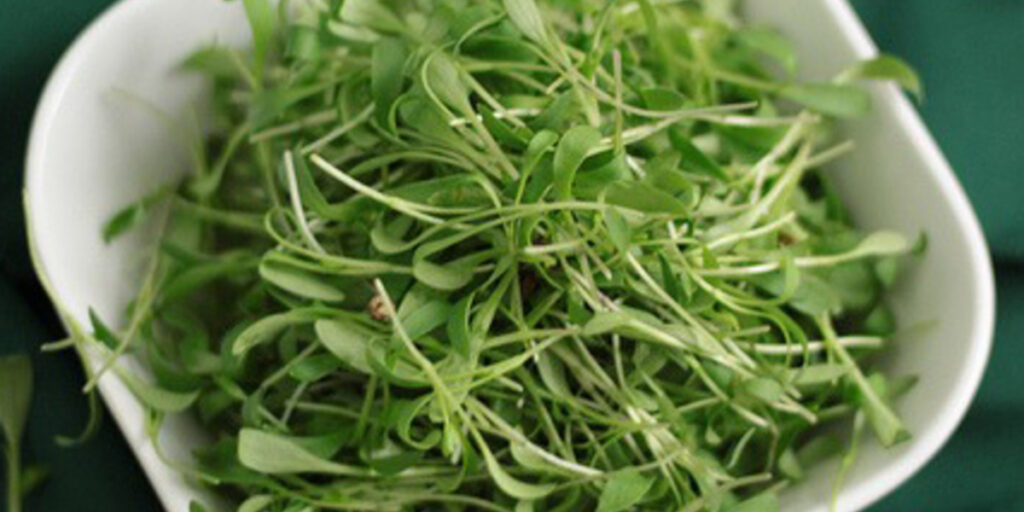
Microgreens of coriander (cilantro) have a pronounced spicy flavor and aroma. Cilantro is an excellent addition to meat dishes, especially grilled ones. Coriander microgreens should be grown in soil and other substrates.
Seeds do not necessarily need soaking, but soaking them in water before sowing stimulates growth. Cilantro prefers a cooler environment with temperatures below +21°C. Additional lighting is recommended no earlier than 6 days after sowing.
Cilantro microgreens are very beneficial for heart and vascular health. They contain many vitamins, as well as phosphorus and potassium. Consuming coriander supports the health of bones, eyesight, the nervous system, and more.
| Flavor | Strong celery flavor with citrus notes |
| Color | Green leaves and stems |
| Pre-soaking | No / Yes (8-12 hours) |
| Germination time | 4–6 days |
| Harvest time | 7–18 days |
Clover
A simple-to-grow microgreen that looks similar to alfalfa and has a nutty flavor. It is added to vinaigrettes and sauces. Clover can be grown using a damp cloth, hydroponic mat, or soil. Germination is fast, and the success rate is high.
Its greens are rich in proteins, vitamins A, B, C, E, K, and other beneficial micronutrients. Sprouted seeds help the body recover faster after illness, remove toxins, and purify the blood.
| Flavor | Mild earthy, nutty, crunchy, juicy |
| Color | Bright green leaves and light greenish-white stems |
| Pre-soaking | No / Yes (4-6 hours) |
| Germination time | 4–5 days |
| Harvest time | 7–12 days |
Leaf Cabbage (Kale)
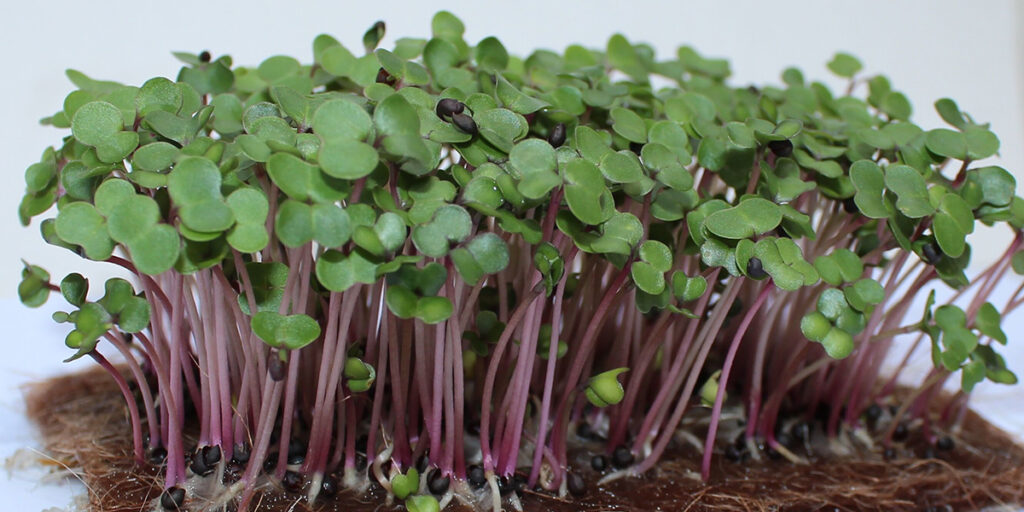
Microgreen kale is not the most popular microgreen, but it is characterized by ease of cultivation. Kale is used in salads and smoothies without heat treatment. The taste of kale sprouts pairs well with fresh vegetables and herbs. During the first few days, it is recommended to gently remove seed hulls from the sprouts to facilitate harvesting later.
Like other types of cabbage, it is incredibly healthy. Kale sprouts contain very valuable vitamins and minerals in large quantities. Kale is considered a superfood because it offers many benefits for the human body, including reducing cholesterol harm to lower the risk of heart disease. Microgreens contain forty times more nutrients than mature cabbage.
| Flavor | Mild cabbage flavor |
| Color | Thick green leaves and pinkish-white stems |
| Pre-soaking | No |
| Germination time | 1–2 days |
| Harvest time | 7–10 days |
Garden Cress
Microgreens with a distinctive aroma and sharp mustard flavor. A good addition to side dishes, sauces, and salads. The taste is refreshing and easily distinguishable. To grow garden cress, minimal humidity must be maintained.
Garden cress is rich in carotene, B vitamins, iron, and magnesium. It also contains more sulfur and sodium compared to other vegetables. Garden cress microgreens improve gastrointestinal function, help regulate sleep, and normalize blood pressure.
| Flavor | Peppery, sharp |
| Color | Thick green leaves and yellowish-white stems |
| Pre-soaking | No/Yes (4–6 hours) |
| Germination time | 3–5 days |
| Harvest time | 5–7 days |
Cucumber
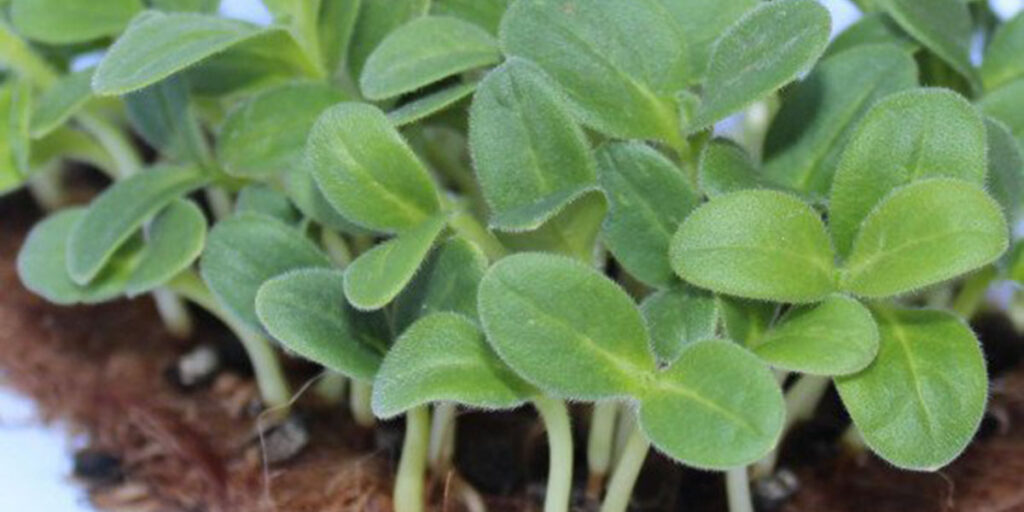
Microgreens of cucumber are very easy to care for. They sprout quickly and grow well under suitable conditions. Within just two days, the first pair of cotyledons and juicy stems appear.
The microgreen has a mild, refreshing cucumber flavor and pairs well with salad mixes and cold soups. Cucumber can be grown both in soil and other substrates.
| Flavor | Juicy, mild, cucumber-like |
| Color | Bright green leaves and stems |
| Pre-soaking | No |
| Germination time | 1–2 days |
| Harvest time | 7–12 days |
Dandelion
When it comes to growing microgreens, dandelions may be an unexpected choice. After all, it is a pesky weed where we live. But in fact, all parts of the dandelion (root, stem, and leaves) are edible both at the microgreen stage and as a young plant.
Dandelion microgreen seeds sprout easily but are small in size, so it may take up to three weeks before you can harvest them.
Dandelion greens surpass spinach and broccoli in nutritional value. Dandelion is a powerful antioxidant rich in vitamins C, K, and A, as well as omega-3 and omega-6 fatty acids and protein.
It supports liver function, aids digestion, improves bone and dental health, supports vision, strengthens immunity, helps regulate muscle function, acts as a natural diuretic, and reduces swelling and inflammation.
| Flavor | Slightly bitter, earthy |
| Color | Bright green leaves, greenish-white stems |
| Pre-soaking | No |
| Germination time | 2–3 days |
| Harvest time | 12–25 days |
Dill
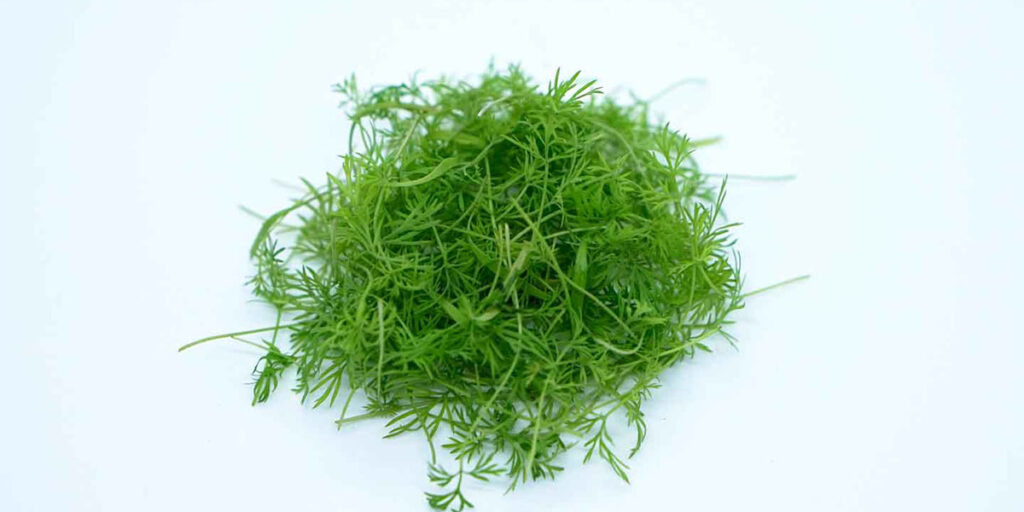
Thanks to its bright and piquant flavor, dill is often used to garnish soups, fish, and seafood dishes. Dill microgreens have a unique aroma that may attract some small insects.
Growing microgreens at home is quite simple. For best results, the air temperature should be maintained at around +21°C. To prevent the plant from drying out, it should be misted at least twice a day.
Dill is rich in nutrients beneficial for health. For example, a 100-gram serving of dill increases the intake of vitamin A, a fat-soluble vitamin. The fragrant delicate microgreens contain a large amount of vitamin P, which strengthens blood vessel walls and helps prevent varicose veins.
| Flavor | Mild dill and piquant |
| Color | Bright green leaves and pinkish-white stems |
| Pre-soaking | Yes |
| Germination time | 4–5 days |
| Harvest time | 12–15 days |
Endive (Frisée)
This crop is sometimes confused with chicory, but it is a separate type of microgreens with a very small size. Endive has a slightly bitter but pleasant taste, which contrasts well with the sweetness of salad mixes.
Endive can be harvested starting from the 10th day after sowing, but to obtain larger greens, it is better to grow it in soil. This allows it to absorb more nutrients for a higher yield.
| Flavor | Slightly bitter |
| Color | Bright green leaves and pale green stems |
| Pre-soaking | No |
| Germination time | 2–3 days |
| Harvest time | 7–12 days |
Beans
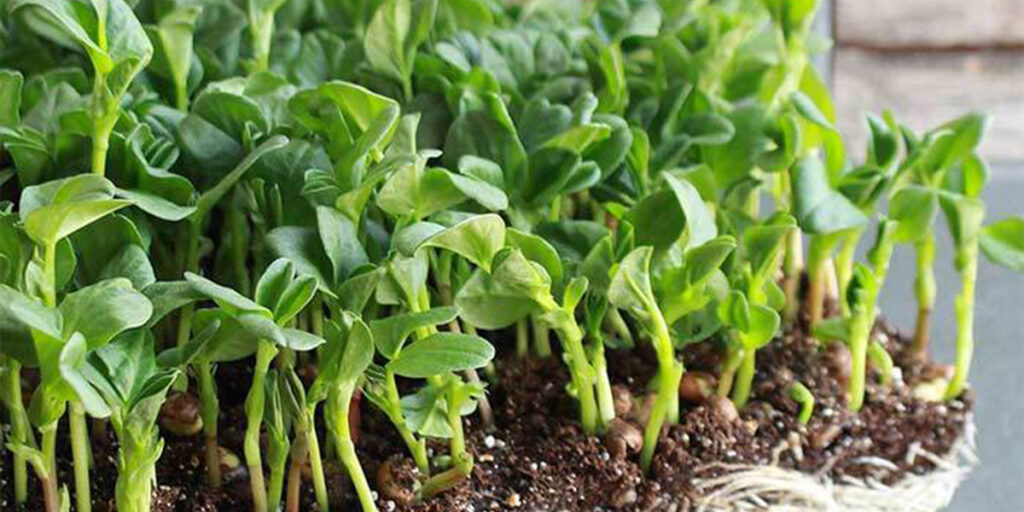
This is a delightful crunchy microgreen with a sweet nutty flavor, similar to sunflower.
Unlike other legumes, beans grow quite quickly. To avoid germination problems, it is recommended to soak bean microgreen seeds overnight (12-24 hours). To provide nutrition, it is better to sow the seeds in soil.
Bean microgreens contain a lot of protein, dietary fiber, phytonutrients, folic acid, levodopa, vitamin B, and minerals. Beans reduce cholesterol levels, prevent cancer development, improve heart health, digestion, and much more.
| Flavor | Juicy, crunchy, nutty, and sweet |
| Color | Thick green leaves and light green stems |
| Pre-soaking | Yes (12-24 hours) |
| Germination time | 3–4 days |
| Harvest time | 12–15 days |
Fennel
Microgreens that contain significantly more beneficial substances than mature plants. Fennel microgreens are often used as a seasoning or garnish due to their strong aroma reminiscent of anise. Their stems pair well with meat and fish and serve as a main ingredient in soups. Fennel can be grown both in soil and on flax mats.
Young fennel shoots contain vitamins C, E, and K, antioxidants, potassium, and fiber. Regular consumption of sprouts improves the nervous system, enhances gastrointestinal function, and helps reduce cholesterol.
| Flavor | Mild licorice and sweet |
| Color | Bright green leaves and greenish-white stems |
| Pre-soaking | No |
| Germination time | 2–3 days |
| Harvest time | 10–14 days |
Fenugreek (Mushroom Grass)
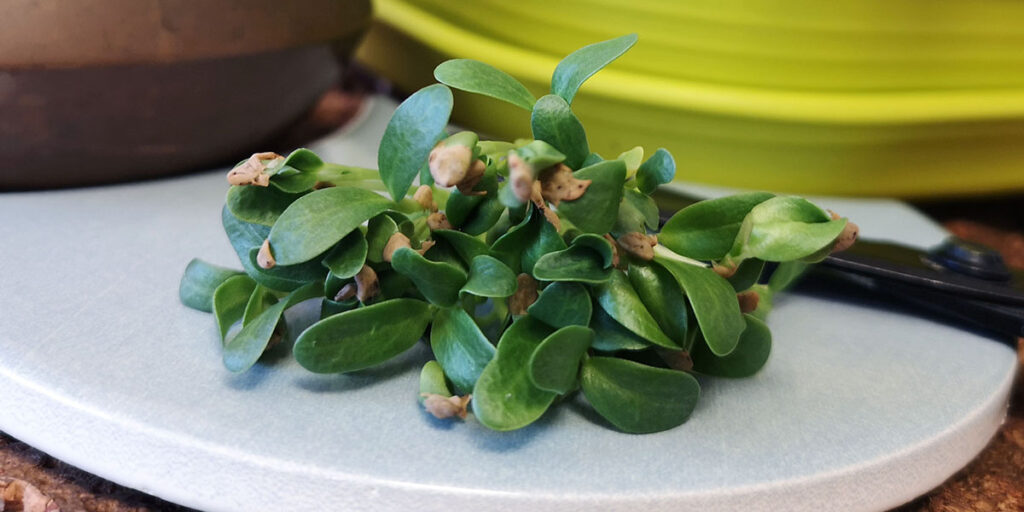
Another popular microgreen for home growing with a unique bitter taste. Fenugreek is widely used in traditional cooking and contains many vital nutrients.
Mushroom grass is easy to sprout (usually takes 1-2 days) in soil and other substrates, including a jar, a sprouting tray, or simply a wet cloth.
Fenugreek microgreen contains vitamin C, protein, fiber, antioxidants, potassium, iron, and much more. It is beneficial for controlling blood insulin levels, heart health, improving digestion, and cancer prevention.
| Taste | Refined bitter taste, moderately spicy and nutty |
| Color | Thick green leaves and light green stems |
| Pre-soaking | No/Yes (8 hours) |
| Sprouting time | 2-3 days |
| Harvest time | 10-14 days |
Flax
An excellent microgreen to add a light nutty flavor to salads and smoothies. Seeds are not recommended to be soaked before sowing, as they develop a gel-like coating upon contact with water, similar to chia seeds. Therefore, they need a bit more time to sprout. After sowing, trays with seeds should be kept in the dark for 4 days.
Flax sprouts contain a large amount of protein, crude fiber, simple sugars, calcium, phosphorus, zinc, copper, and other minerals. Consuming flax microgreens is very beneficial for athletes, as it improves digestion and bone health.
| Taste | Nutty and moderately spicy |
| Color | Bright green leaves, greenish or pinkish stems |
| Pre-soaking | No |
| Sprouting time | 2-3 days |
| Harvest time | 8-12 days |
Hemp
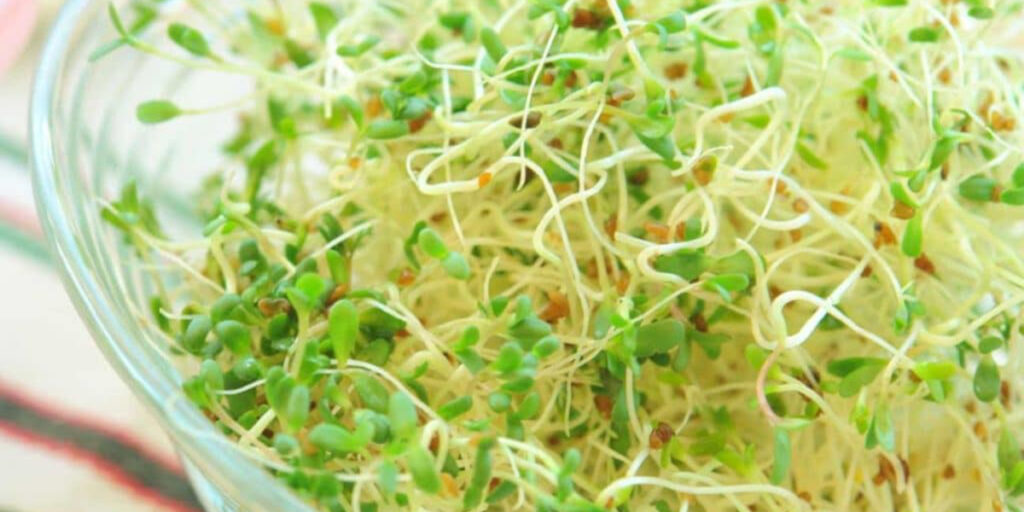
Hemp microgreens are among the fastest-growing greens and can be harvested on the 6th day. Hemp has a characteristic crisp and nutty flavor.
Microgreens are rich in fiber and many vital nutrients, including certain hemp-specific flavonoids that are beneficial for human health.
They also contain amino acids, omega-3s, and vitamin C. These are helpful due to their anti-inflammatory effects, prevention of PMS symptoms, and more.
| Taste | Nutty, mild |
| Color | Dark green leaves, brownish stems |
| Pre-soaking | Yes (4–6 hours) |
| Sprouting time | 1–2 days |
| Harvest time | 7–10 days |
Kohlrabi
These are very beautiful sprouts: purple stems and green leaves. That’s why they’re very popular in restaurants. The aroma is similar to turnip but a bit milder, and the taste is slightly sweet. They pair well with both meat and vegetarian dishes.
Kohlrabi microgreens can be grown in just 2 weeks, but if possible, wait until the second pair of leaves appears.
Due to its high vitamin C content, this cabbage is often called the “northern lemon.” Kohlrabi microgreens contain a large amount of fiber, which is very beneficial for the digestive system. Thanks to high levels of calcium, iron, and manganese, they also support bone health.
| Taste | Mild, sweet |
| Color | Bright green leaves, white and purple stems |
| Pre-soaking | No |
| Sprouting time | 1–3 days |
| Harvest time | 7–10 days |
Komatsuna (Mustard Spinach)
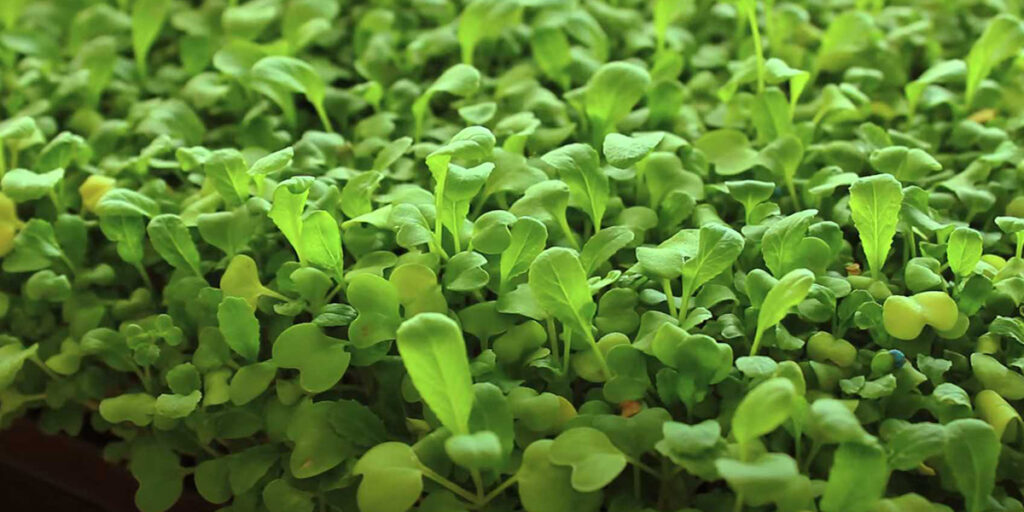
A very aromatic microgreen that enhances the flavor of any dish. Its uniquely tangy and spicy taste also makes komatsuna a great addition to many salad mixes.
Mustard spinach microgreens strengthen the immune system and the body’s natural defenses. Komatsuna is rich in carotene, making it an essential food for people with vision disorders. Carotene is necessary for healthy skin, improves elasticity, and helps clear breakouts.
| Taste | Cabbage-mustard flavor, rich and slightly sweet |
| Color | Yellowish-green leaves and greenish-white stems |
| Pre-soaking | No |
| Sprouting time | 2–3 days |
| Harvest time | 10–14 days |
Leek
These are thin dark green leaves with a delicate aroma and a mildly sweet taste without sharpness. Like garlic, leek microgreens often retain a seed husk on the tip, which can be difficult to remove. Leeks are used to garnish dishes and add aroma. They are ideal for soups, meats, and gravies.
Microgreens are rich in antioxidants, vitamins, and minerals, making them an essential part of a healthy diet. They contain vitamins A and C, B-group vitamins, calcium, magnesium, and potassium.
Leek microgreens are an excellent source of fiber, helping to lower blood sugar levels and support cardiovascular health. It has been proven that adding leeks to the diet may reduce the risk of certain cancers and promote gastrointestinal health.
| Taste | Strong, mild onion flavor, slightly sweet |
| Color | Light green stems |
| Pre-soaking | No/Yes (4–6 hours) |
| Sprouting time | 2–5 days |
| Harvest time | 7–14 days |
Lemon Balm
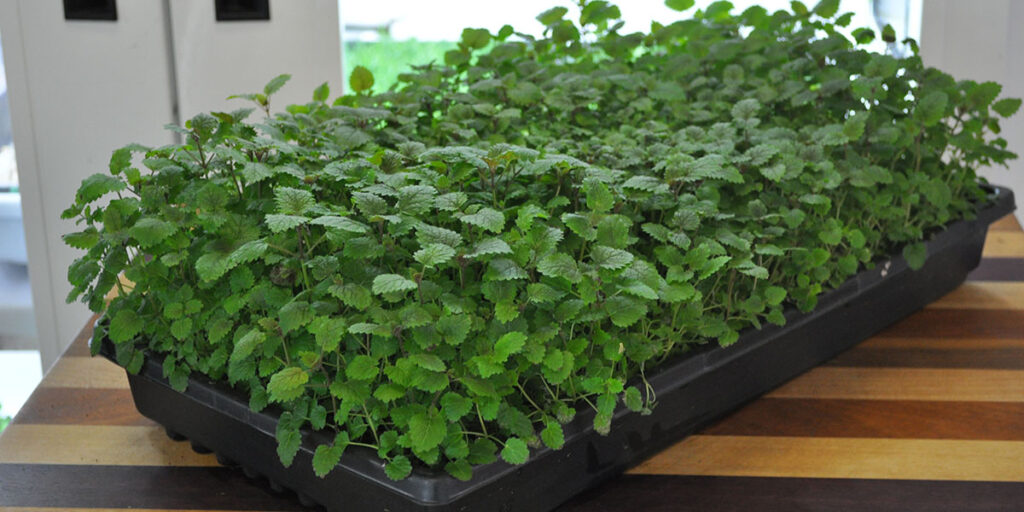
Lemon balm microgreens have a strong citrus aroma and a lemon flavor, making them a great choice for garnishing dishes. They grow slowly, which means a longer harvest period. For the same reason, the crops are often susceptible to rot, so proper ventilation is essential.
Thanks to their fiber content and appetizing taste, lemon balm aids digestion, especially after overeating. It is widely used in juices, desserts, and smoothies to enhance flavor.
| Taste | Lemon flavor and aroma |
| Color | Bright green leaves and greenish stems with a pinkish tint |
| Pre-soaking | No |
| Sprouting time | 3–4 days |
| Harvest time | 14+ days |
Lemongrass
Cymbopogon, like lemon balm, has a strong refreshing lemon aroma. For many years, it has been used in various traditional culinary recipes, including steaks, soups, and seafood. The soft and tender stem of lemongrass makes it suitable for adding sweetness to a dish.
| Taste | Strong lemon and sweet |
| Color | Bright green on the upper leaves, red or purple on the lower stems |
| Pre-soaking | No |
| Sprouting time | 2–3 days |
| Harvest time | 14+ days |
Lentil
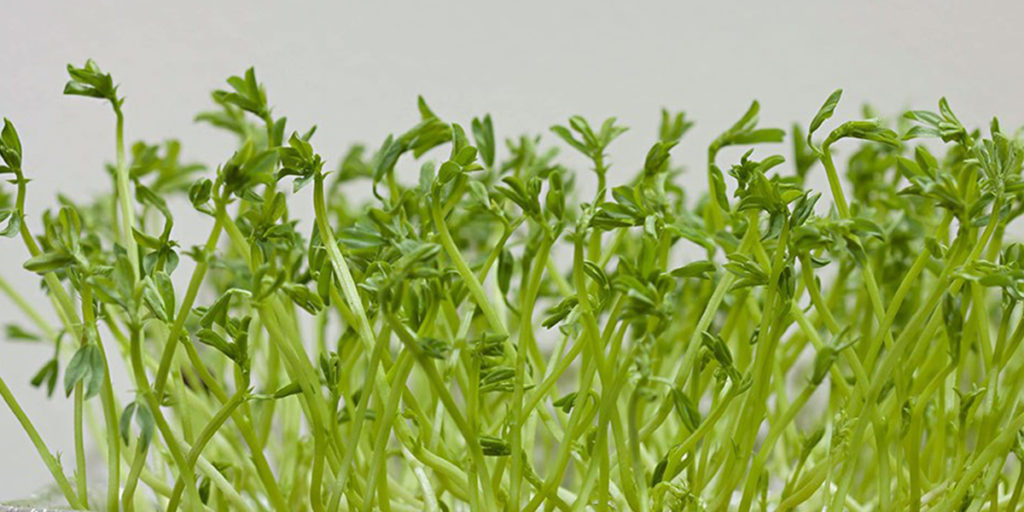
A tasty legume grass with a unique composition of trace elements (magnesium, iron, etc.). In ancient times, this crop was called “meat for the poor.” Lentil microgreens are very similar to soy or barley. Suitable for both cold and hot dishes.
Lentils can be grown on a damp paper towel or in a jar, and they also grow well in soil. Lentil seeds are quite large, so for better germination it’s best to soak them in water for 8–12 hours before sowing.
Lentil microgreens contain a high amount of protein, fiber, vitamins (A, B, C, E), low fat content, folic acid, potassium, and more. They stimulate blood circulation and cleanse blood vessel walls.
| Taste | Moderately bitter, pea-like |
| Color | Bright green leaves and light green stems |
| Pre-soaking | Yes (8–12 hours) |
| Sprouting time | 2–3 days |
| Harvest time | 9–12 days |
Lettuce
An excellent element of a healthy diet. The taste of young leaves is more tender and juicy compared to the mature plant. Lettuce microgreens are well suited for sandwiches, vegetable smoothies, and fish. Additionally, for sandwiches they can be grown to a larger size for up to three weeks.
When growing lettuce microgreens, it is recommended to keep them in the dark for about 3–4 days, as they need to seek light in order to grow tall.
Lettuce microgreens have shown a higher level (up to 69 times!) of nutrients than their mature counterpart. Also, 7-day-old lettuce microgreens have the highest concentration of phenolic compounds and antioxidants compared to other growth stages, which plays a major role in cancer prevention.
| Taste | Mild, rich flavor with a slight bitterness |
| Color | Bright green leaves and pale green stems |
| Pre-soaking | No/Yes (4–6 hours) |
| Sprouting time | 2–3 days |
| Harvest time | 10–14 days |
Lovage
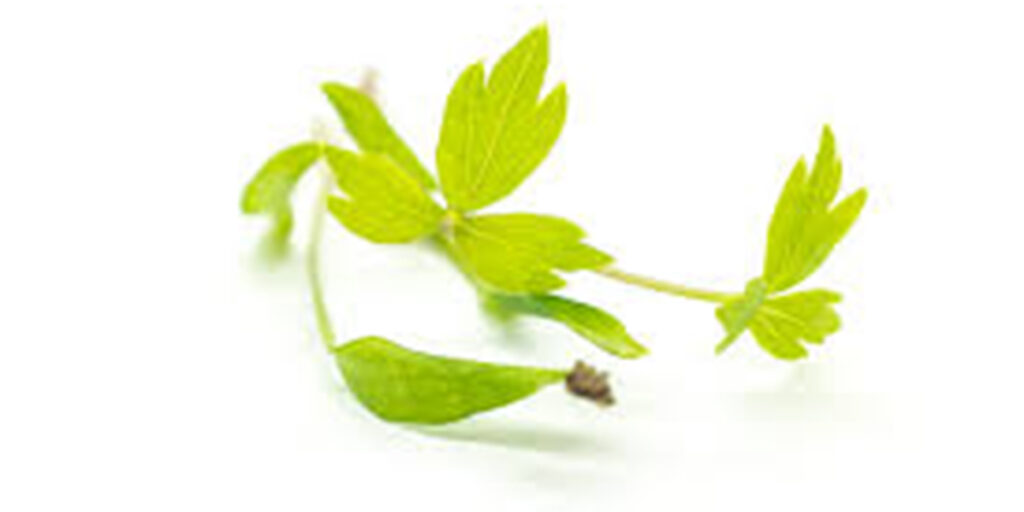
A fragrant herb used for seasoning salads and pickles. Lovage microgreens have a celery-like taste but milder. Unlike the mature plant, the microgreens have more tender stems and leaves, which are perfect for soup.
The sprouts germinate quite slowly (about a week), so it is recommended to soak the seeds or cover them overnight with a damp paper towel to speed up growth. During cultivation, it is not recommended to turn off the lighting even during germination.
As a leafy plant, lovage brings many health benefits. Microgreens are rich in minerals and vitamin C. Lovage speeds up metabolism, improves digestion, cleanses the circulatory system, and strengthens the heart.
| Taste | Mild celery flavor with a slight bitterness |
| Color | Yellowish-green stems and leaves |
| Pre-soaking | Yes/No |
| Germination time | 6–14 days |
| Harvest time | 18–24 days |
Corn Salad or Mache
This is a leafy vegetable that grows well in cold weather and has a mild, pleasant taste. Thanks to its crisp and tasty leaves, it is known as one of the best options for fresh salads. Growing mache as microgreens is quite simple. Growing mature plants takes about 20–30 days.
Corn salad is rich in beta-carotene and antioxidants, which the body converts into vitamin A. This vitamin plays an important role in immune system health, vision, and skin health.
Mache is a source of vitamin B9 (folate), which is especially important for pregnant women, fetal development, growing children, and recovery.
| Taste | Mild, nutty |
| Color | Bright green leaves and pale green stems |
| Pre-soaking | No |
| Germination time | 2–3 days |
| Harvest time | 8–12 days |
Giant Orache
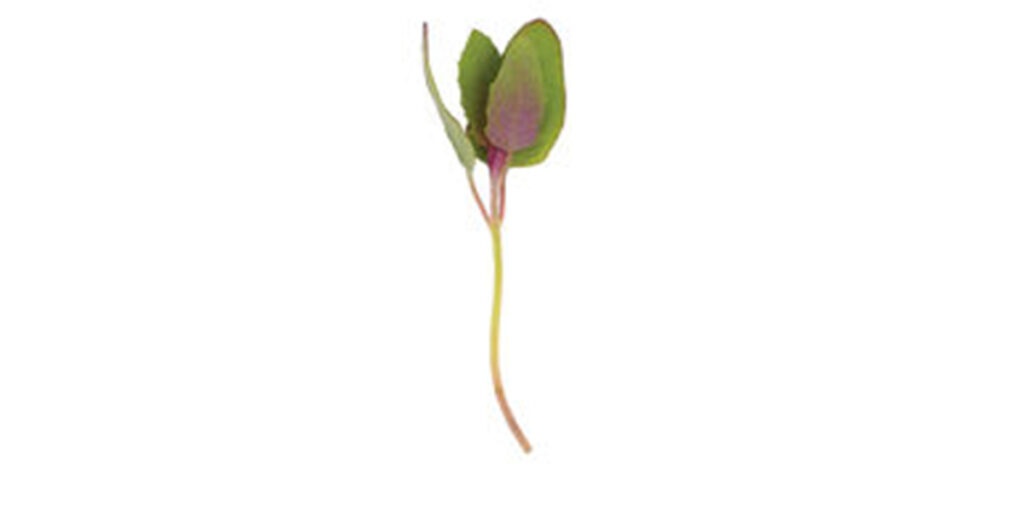
A leafy vegetable unpopular in Ukraine, also known as giant orache or purple orache. The taste of giant orache microgreens is unremarkable, similar to spinach but milder. The sprouts are fully edible and perfect for plate decoration.
Since orache sprouts slowly, it is better to soak the seeds beforehand. Supplemental lighting is recommended to start 3–4 days after sowing.
Giant orache microgreens have high nutritional value as they are rich in vitamins C and E, essential fatty acids, iron, calcium, minerals, and antioxidants that effectively combat free radicals. Giant orache contains a small amount of oxalic acid, similar to that found in sorrel, chard, or beet greens.
| Taste | Mild spinach flavor |
| Color | Green leaves and stems |
| Pre-soaking | Yes |
| Germination time | 4–8 days |
| Harvest time | 16–25 days |
Marigolds (Tagetes)
Another unexpected type of microgreens. Tagetes microgreens give dishes a piquant tangerine flavor with a slight spicy or minty note. They are used to flavor drinks and desserts.
Growing marigold microgreens is quite simple. You need to sow the seeds, water them well, and leave them for 3–4 days to germinate. After that, provide additional lighting and the harvest will be ready on the 10th day.
Marigold microgreens are a good source of beta-carotene, which is an antioxidant. They are a beneficial addition to the diet, as the sprouts contain potassium, which helps regulate fluid levels in the body. In addition to vitamins and minerals, marigolds contain proline, which helps strengthen joints and increase collagen production.
| Flavor | Citrusy or tangerine, light and spicy |
| Color | Bright green leaves and stems |
| Pre-soaking | No |
| Germination time | 2–4 days |
| Harvest time | 8–14 days |
Marjoram
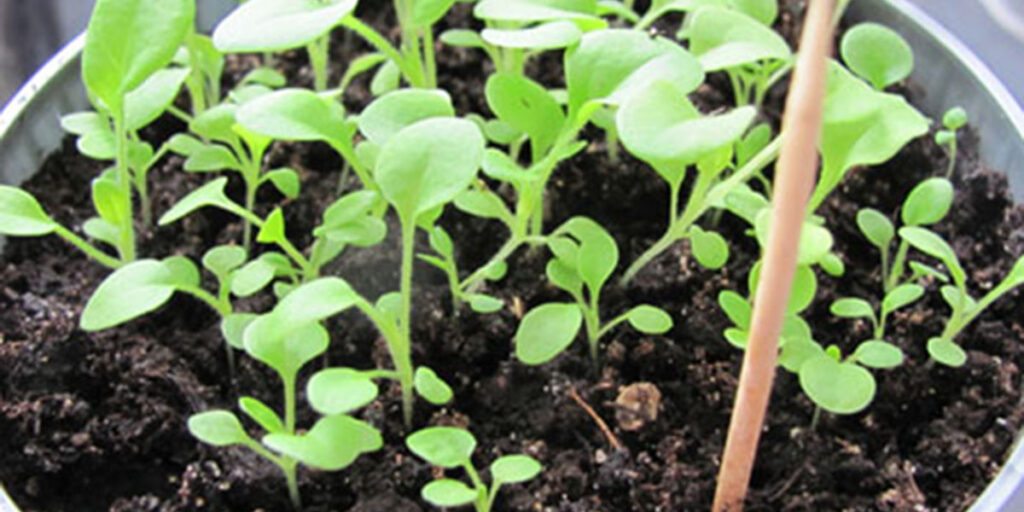
A common plant that is often confused with oregano. In fact, they both belong to the same group and have similar flavors and aroma. Marjoram microgreens are relatively low-growing and airy. Despite their tiny size, they have a full set of savory flavor and health benefits.
At the cotyledon stage, marjoram tastes like mint, and after the appearance of true leaves, its aroma becomes significantly stronger.
Marjoram seeds germinate in 4–6 days. Additional light improves germination. The soil should be relatively dry, otherwise the tiny seeds easily rot.
| Flavor | Savory, strong, slightly astringent and sweet, similar to oregano but milder |
| Color | Light green leaves and stems |
| Pre-soaking | No |
| Germination time | 2–3 days |
| Harvest time | 10–14 days |
Mint
Not only an aromatic herb for making mojitos, but also a good folk remedy. Mint microgreens enhance the flavor of hot and cold drinks. The microgreens have the same strong minty taste as the mature plant, but their leaves and stems are more delicate and smooth.
Mint sprouts are short and have very tiny dark brown seeds. The seeds may germinate unevenly, and this is completely normal.
In microgreen form, mint is especially beneficial for health, as it can help with bad breath, improve brain function, and reduce irritable bowel syndrome. Mint has a calming effect on the nervous system.
| Flavor | Sweet, sharp, minty aroma |
| Color | Light green leaves and stems |
| Pre-soaking | No |
| Germination time | 2–3 days |
| Harvest time | 10–14 days |
Millet microgreens
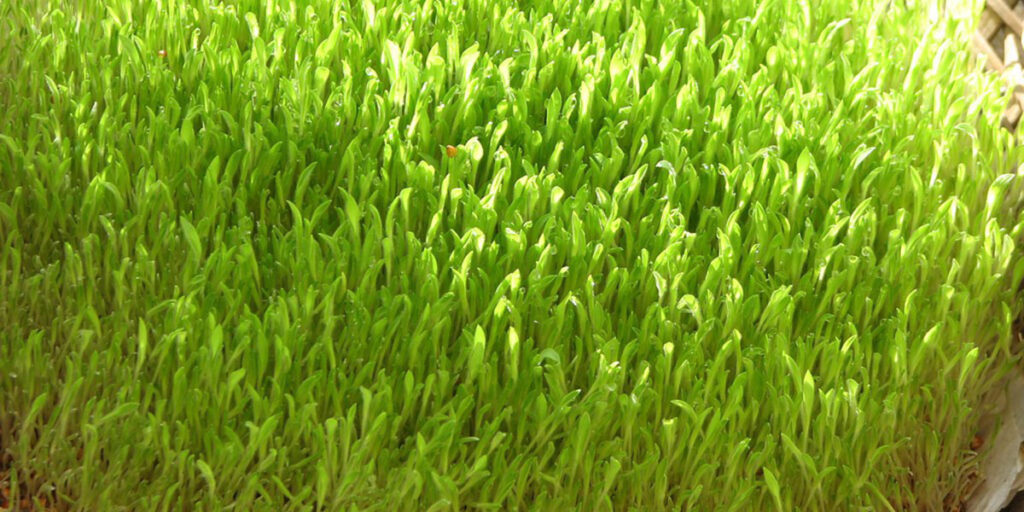
Microgreens of a grain that is usually used as feed for chickens, cows, and horses. But in fact, millet is very nutritious and beneficial for humans. Like barley, it has a mild grassy taste. Some people prefer to simply sprout millet, grind it into flour, or cook it as porridge.
Millet microgreens contain beneficial proteins, carbohydrates, essential amino acids, minerals, and many other nutrients important for the human body. Sprouts can be used in salads with other vegetables or added to healthy smoothies.
When growing millet in large volumes, make sure it has good ventilation to avoid mold problems. It’s best to turn on the light above the sprouts 4 days after sowing.
| Flavor | Mild, grassy |
| Color | Bright green leaves and whitish stems at the bottom |
| Pre-soaking | Yes (4–8 hours) |
| Germination time | 1–2 days |
| Harvest time | 12 or more days |
Mizuna (Mitsuna, Japanese mustard greens)
Sprouts with aromatic leaves that can enhance the flavor of salads, sandwiches, or be eaten as a side dish. Depending on the type and variety, mizuna can be green or red.
During the first few days after germination, a white fluffy coating appears on the roots. Don’t worry, these are just white root hairs that help the seedlings absorb moisture better. Japanese mustard greens need additional light 3–4 days after sowing.
This crop regulates the body’s water balance and cleans the blood vessel walls. Mizuna microgreens are low in calories but high in essential vitamins and antioxidants. They can improve eye, bone, and immune health, and have anti-tumor effects.
| Flavor | Mild, savory, and slightly spicy |
| Color | Green or purple leaves and yellowish, pinkish, or white stems |
| Pre-soaking | No / Yes (4–8 hours) |
| Germination time | 1–2 days |
| Harvest time | 5–14 days |
Mung Pea (Mung Bean)
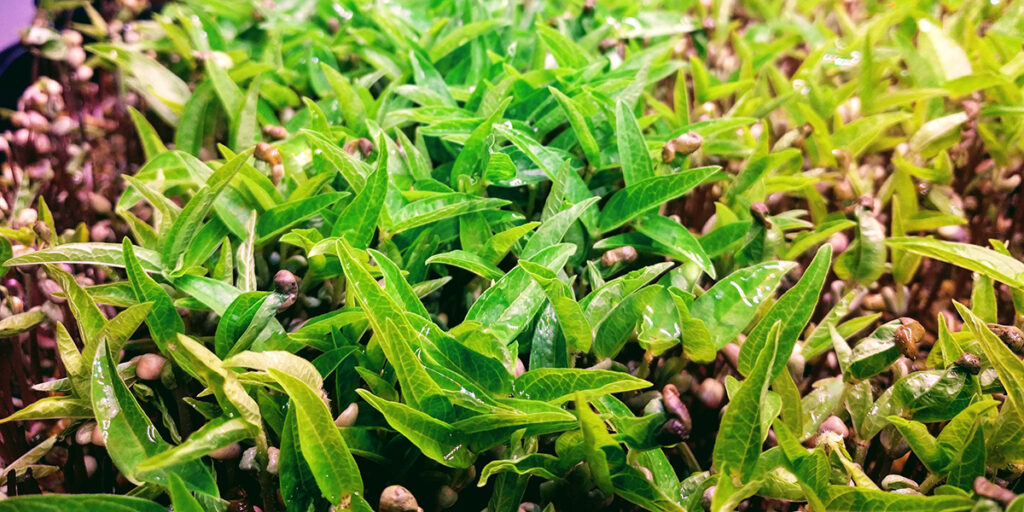
Microgreens from mung peas have long veined leaves with a mild nutty-legume flavor. Usually, mung beans are simply sprouted in a jar, but you can also grow nutritious microgreens from them in soil or another substrate.
As with other legumes, it’s best to soak the seeds overnight for better germination. Additional light should be turned on no earlier than 3 days after sowing. Mung microgreens grow very quickly, and you can harvest them within one week.
Young mung sprouts can be eaten fresh, as well as sautéed or pickled with other vegetables. Mung contains a lot of beneficial nutrients for the human body. Due to the high level of antioxidants, it may reduce the risk of developing chronic diseases.
Mung peas are rich in potassium, magnesium, and fiber, which can lower blood pressure. The fiber in mung beans supports digestive health and weight loss by suppressing hunger and increasing satiety hormones. Folic acid helps support a healthy pregnancy.
| Flavor | Mild legume flavor, slightly buttery |
| Color | Light green leaves, and green stems with a reddish underside |
| Pre-soaking | Yes (8–12 hours) |
| Germination time | 1–2 days |
| Harvest time | 7–10 days |
Nasturtium
Primarily known as a flower, but few people know that its sprouts are very beneficial. Nasturtium microgreens have a pleasant aroma and a spicy flavor, resembling mustard, cress, or horseradish. Young sprouts are added to cheeses, vegetable salads, and egg dishes. Moreover, not only the sprouts but also the flowers of nasturtium are edible.
For more about other edible flowers and how to use them, read the article:
“Edible Flowers and Their Types“
For better germination, it is recommended to soak the seeds in warm water for a couple of hours before sowing. Nasturtium likes a moist environment, but because of that, it is prone to mold development. In such cases, simply spray a little diluted hydrogen peroxide over the sprouts for disinfection.
A unique feature of nasturtium leaves is that they contain waxy nanostructures that prevent water from being absorbed through the upper leaf surface. Thanks to this, when water falls on the leaves, it merely removes dirt and debris from the surface, allowing photosynthesis to continue.
Nasturtium microgreens are an excellent source of vitamins A, C, and D, beta-carotene, iron, manganese, and flavonoids. With frequent consumption, nasturtium boosts immunity due to its high vitamin C content. It also contains sulfur, which helps remove toxins and reduces swelling.
| Flavor | Spicy wasabi flavor |
| Color | Glossy yellow-green leaves and green or pink stems |
| Pre-soaking | Yes (8–12 hours) |
| Germination time | 10–15 days |
| Harvest time | 14–21 days |
Bulb Onion
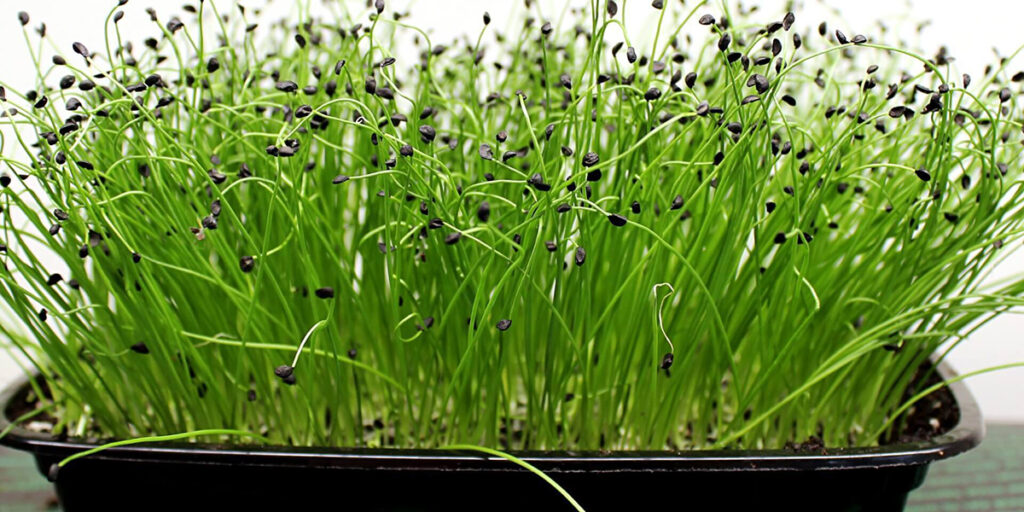
The greens taste similar to young green onions freshly cut from the garden. They can be added to any dishes and pair especially well with meat and vegetables.
A downside of onion microgreens is that seed husks remain on the tips of the sprouts, and they grow slowly.
However, onions have many advantages. They are very juicy and crispy in taste, making them perfect for salads and soups. Their thin shoots contain ascorbic acid and vitamins E and B. Onion suppresses the activity of harmful bacteria in the mouth and digestive system.
Eating young onion sprouts lowers cholesterol levels and helps normalize blood glucose levels.
| Flavor | Strong, slightly sweet, sharp, and moderately spicy |
| Color | Green tops and white stems at the bottom |
| Pre-soaking | No/Yes (4–6 hours) |
| Germination time | 2–5 days |
| Harvest time | 7–14 days |
Oregano
This is a common culinary herb often mistaken for marjoram, although both belong to the mint family. It has a unique sharp flavor and is used as a seasoning for soups, pizza, and spaghetti to add zest to dishes.
Growing oregano microgreens takes a lot of time. However, it’s worth waiting a bit to get aromatic and beneficial sprouts.
Fresh oregano greens are an excellent antibacterial agent. They are also rich in antioxidants that help prevent cell damage, and are a great source of fiber, vitamin K, manganese, iron, vitamin E, tryptophan, and calcium.
| Flavor | Sharp, earthy, slightly minty |
| Color | Bright green leaves and stems |
| Pre-soaking | No |
| Germination time | 5–7 days |
| Harvest time | 16–22 days |
Parsley
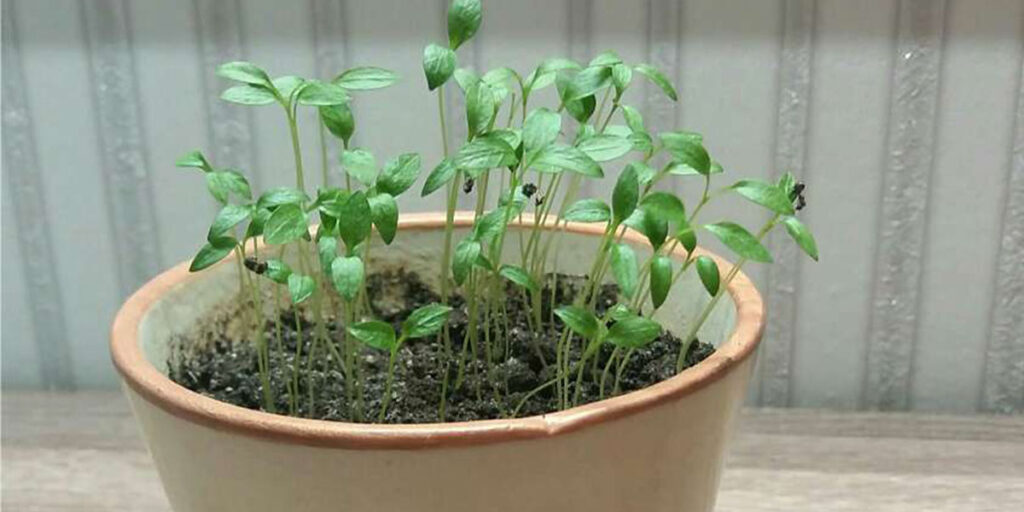
A popular green that can be easily grown as microgreens at home. Its flavor is more delicate and aromatic than mature parsley. Parsley can be added to soups, vegetables, and meat dishes.
Growing and harvesting microgreens takes quite a long time. The harvest can begin from the 16th to the 30th day.
Parsley microgreens have all the benefits, including relaxing smooth muscle tissue (especially important for asthmatics), supporting good vision (they contain lutein and zeaxanthin), and promoting proper blood circulation and heart health.
Parsley harmoniously combines all vitamins and trace elements that fight allergies, hypertension, and various inflammations. It is beneficial for strengthening bone tissue and immunity.
| Flavor | Mild parsley flavor, refreshing, juicy |
| Color | Bright green leaves and stems |
| Pre-soaking | Yes |
| Germination time | 5–7 days |
| Harvest time | 18–30 days |
Pea
Pea microgreens have a slightly sweet taste with a nutty undertone, reminiscent of young green peas. The young stems with leaves and tendrils are consumed. Thanks to their crunchy texture, peas pair well with fresh vegetables and make a great garnish for vegetable soups.
Pea microgreen seeds are large and take up a lot of space, so they need to be sown densely to obtain a thick harvest. The pea tendrils taste slightly sweet with a mild bitter aftertaste, while the leaves have a texture similar to spinach.
When growing microgreens, you may notice that peas absorb quite a bit of water, which is completely normal. Therefore, they should be watered 1–2 times a day. They can be grown up to a height of 15–20 cm, which is excellent for business, as they yield a good weight.
The benefits of pea microgreens include fiber, protein, and complex carbohydrates. They are rich in folic acid and vitamins A, C, E, B1, B2, B3, B6. Peas help boost immunity, improve eye health, regulate blood sugar levels, have anti-cancer effects, and much more.
| Flavor | Mild, nutty, slightly sweet, similar to green peas |
| Color | Yellowish-green leaves and pale green stems |
| Pre-soaking | Yes (8 hours) |
| Germination time | 2–5 days |
| Harvest time | 8–12 days |
Corn
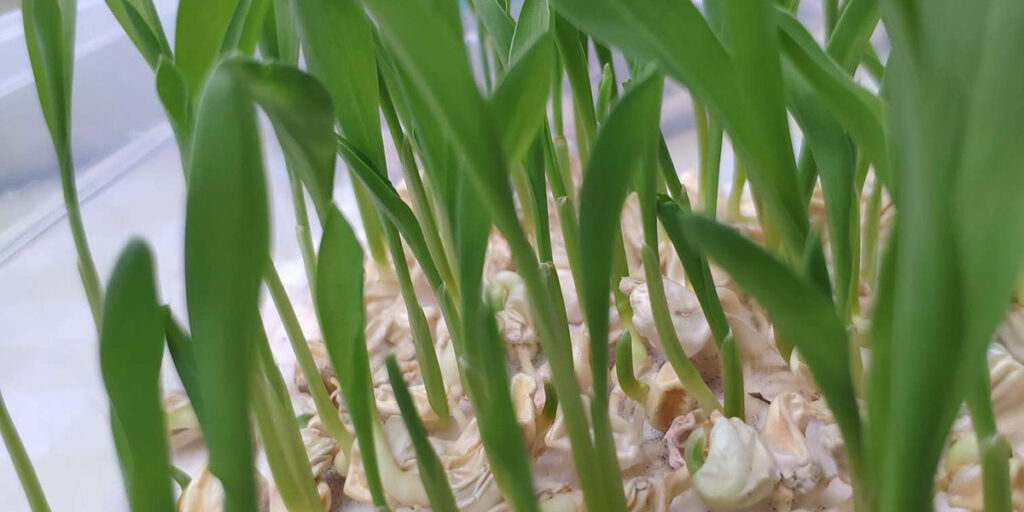
One of the fastest types of microgreens, which can be harvested just 5 days after sowing. Bright yellow shoots with a pleasant sweet taste that will decorate any dish. The roots of the sprouts are crunchy with a bittersweet flavor. When exposed to light, the shoots turn green, become fibrous, and acquire a bitter grassy taste. Ideal for salads and snacks.
This microgreen has long been popular in European restaurants. In Ukraine, it is still gaining momentum and is successfully used to add freshness and sweetness to desserts. It contains vitamins and minerals. Popcorn corn microgreens contain vitamins A, B, C, and E, iron, calcium, potassium, phosphorus, and magnesium.
| Flavor | Sweet, fibrous, crunchy |
| Color | Yellow or pale green leaves and white stems |
| Pre-soaking | Yes |
| Germination time | 2–3 days |
| Harvest time | 6–8 days |
Pumpkin
Pumpkin seed microgreens are juicy and bitter in taste. They are not very popular, but worth considering as their sprouts contain a lot of beneficial nutrients.
Pumpkin seedlings are rich in protein, fiber, fatty acids, amino acids, vitamins (A, E, B1, B2, B4, B3, B6, B9, C, P, T, K). They also contain macro- and microelements necessary for the proper functioning of the human body.
| Flavor | Mild nutty, bitter, rich |
| Color | Thick green leaves and light green stems |
| Pre-soaking | Yes (2–4 hours) |
| Germination time | 2–4 days |
| Harvest time | 16 days or more |
Purslane
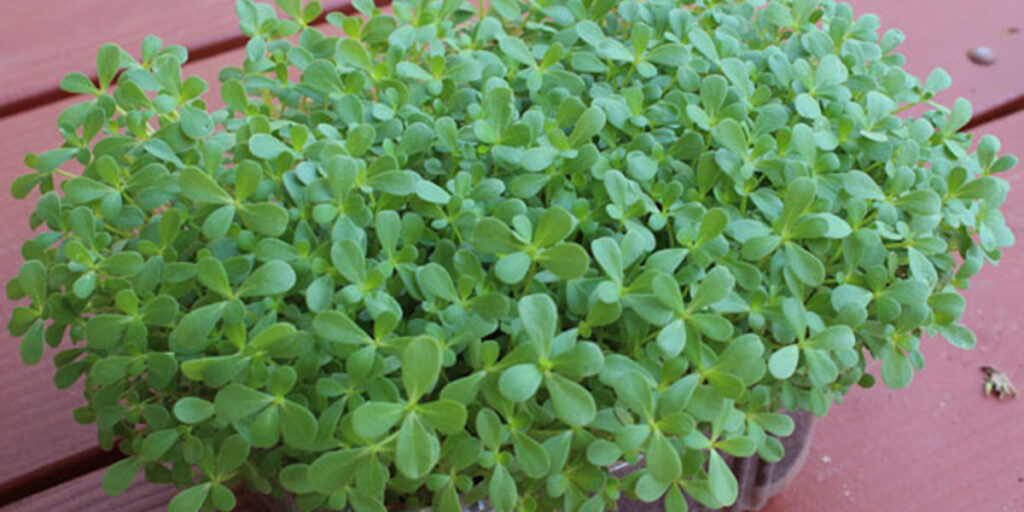
Few people know that this pesky weed is actually very nutritious. Since it is a weed, purslane microgreens are quite easy to grow as they do not require “perfect conditions.”
Young shoots have a rather sharp taste, so they are often added to salads or sandwiches.
Purslane microgreens contain more nutrients than the mature plant, particularly Omega-3 acid, which promotes heart health and reduces the risk of stroke.
Purslane is rich in antioxidants such as vitamins A, C, and E, as well as important minerals (calcium, magnesium, and iron).
| Flavor | Mild aroma, spinach-like taste |
| Color | Thick green leaves and pale pink stems |
| Pre-soaking | No |
| Germination time | 3–5 days |
| Harvest time | 10–14 days |
Quinoa (Kvinoa)
Quinoa is a grain-like plant similar to amaranth. There are two common types of quinoa — red and white. Quinoa microgreens are softer and more delicate than the mature plant and are often used in salads or snacks.
Growing quinoa microgreens is quite simple. It doesn’t require much water, but it is recommended to soak the seeds for about 30 minutes before sowing. The seeds contain a high concentration of saponins, which may cause allergic reactions or nausea. Therefore, it is essential to rinse the seeds several times before sowing.
Quinoa is considered one of the best superfoods in the world because its grains contain all essential amino acids, and provide a good dose of whole-grain carbohydrates and beneficial gluten-free protein.
As you can see, quinoa is rich in various macroelements but relatively lower in calories compared to other grains. Quinoa microgreens are an excellent source of manganese, phosphorus, copper, folic acid, magnesium, and zinc.
| Flavor | Mild, slightly bitter, earthy |
| Color | Bright green leaves, pale brown or red stems |
| Pre-soaking | Yes (30 minutes to 1 hour) |
| Germination time | 1–2 days |
| Harvest time | 7–12 days |
Radish and Daikon
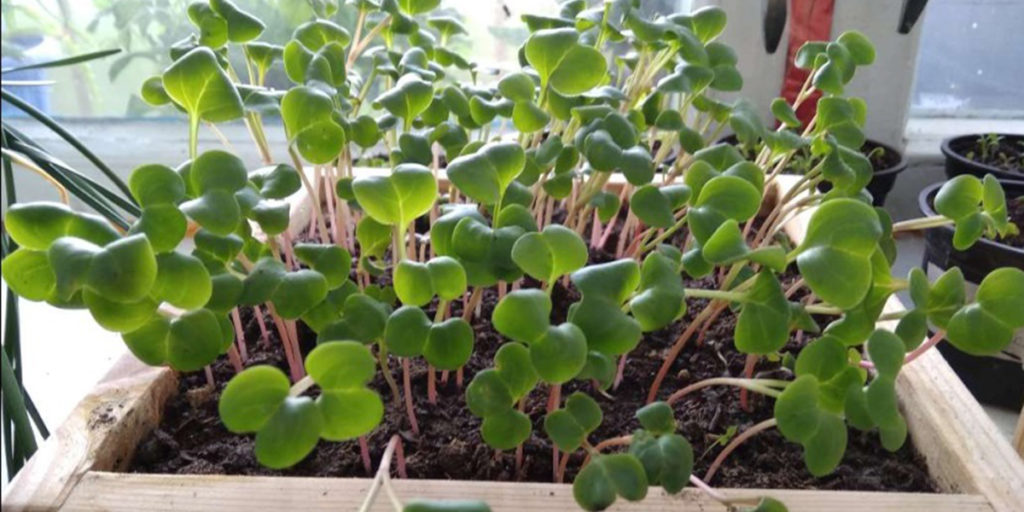
Radish and daikon microgreens are among the most popular and easy-to-grow plants, especially for starting a business. The microgreens have a slightly crunchy texture and a sharp, spicy taste similar to the root vegetable itself. They make an ideal seasoning for salads and meat dishes. Both common radish and daikon can be grown as microgreens.
Generally, soaking the seeds is not necessary, but soaking them for a few hours can improve germination. The crunchy shoots can be harvested on the 6th day after sprouting.
Radish microgreens are a good source of vitamin C, energy, and carbohydrates. They also contain zinc, potassium, folic acid, manganese, copper, sodium, phosphorus, fiber, riboflavin, vitamins B1 and B6, calcium, iron, magnesium, and much more.
Radish microgreens aid digestion thanks to their content of minerals, trace elements, and essential oils, without causing bloating like the root vegetable. Radish acts as a natural diuretic, has anti-inflammatory properties, helps prevent lung cancer, and promotes blood purification.
| Flavor | Mild, crunchy, and spicy |
| Color | Thick green leaves and white or red stems |
| Pre-soaking | No / Yes (6–12 hours) |
| Germination time | 1–2 days |
| Harvest time | 6–7 days |
Brussels Turnip (Rutabaga) Microgreens
A close relative of the turnip, rutabaga microgreens are milder than radish. Their flavor resembles spinach with a slight cabbage bitterness, making them excellent for salads and sandwiches.
Rutabaga microgreens are quite easy to grow and prefer low light for optimal development.
They are very nutritious and low in calories. Rutabaga microgreens contain antioxidants that may help prevent premature aging. Eating them supports healthy digestion and can aid in weight loss.
| Flavor | Peppery, mild |
| Color | Leaves are yellowish-green, stems are white with light pink hues |
| Pre-soaking | No |
| Germination time | 2–3 days |
| Harvest time | 8–12 days |
Sage
A herbaceous plant from the mint family, known for its medicinal properties. Sage microgreens have a strong aroma and an extraordinary taste. They are perfect for enhancing the flavor of various dishes, from seafood to poultry.
Young sage shoots are thin and juicy. It takes at least a week to sprout them.
Sage microgreens contain a large amount of essential nutrients to improve our health. In particular, these are vitamins A, B, D, and E, calcium, iron, magnesium, potassium, and phosphorus.
| Taste | Earthy, strong, bold flavor |
| Color | Bright green leaves and pale green stems |
| Pre-soaking | No |
| Germination time | 7-10 days |
| Harvest time | 18-25 days |
Tumbleweed (Salsola soda)
This plant belongs to the Amaranth family and is also called terrestrial algae. Tumbleweed microgreens have juicy and crunchy stems and thread-like leaves.
Seeds do not need to be soaked before sowing. They will sprout in about a week. For proper development, tumbleweed requires additional light throughout the growing period.
The complex of vitamins and minerals in tumbleweed microgreens can boost immunity, aid weight loss, and improve bone health.
| Taste | Mild, earthy |
| Color | Bright green leaves, pale red or yellowish-green stems |
| Pre-soaking | No |
| Germination time | 7-10 days |
| Harvest time | 14-20 days |
Sesame
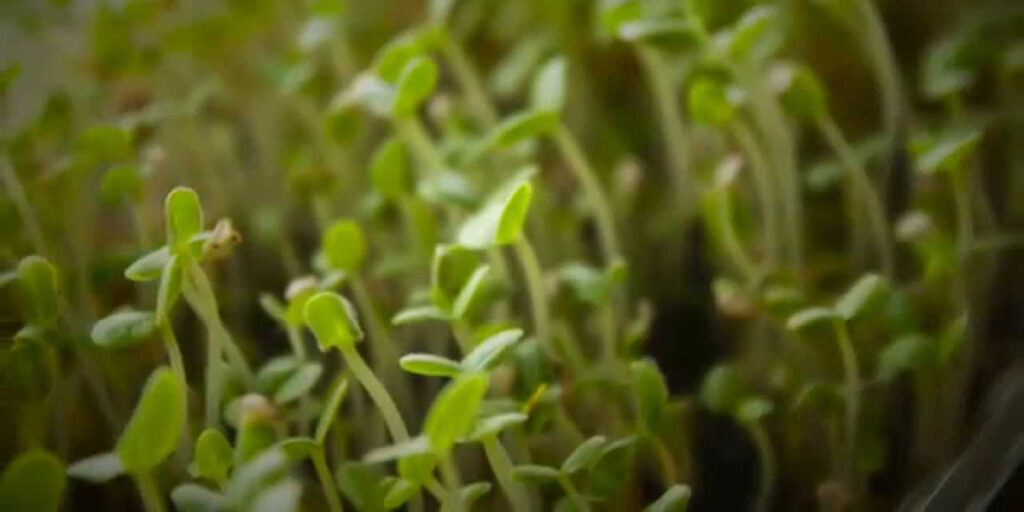
Sesame microgreens have a soft and delightful aroma. Despite their tiny size, they contain a large amount of nutrients beneficial for health.
For better germination, soak the seeds for 2-4 hours. After that, the seeds will look slightly swollen. Nevertheless, they also sprout well without pre-soaking. Sesame can also be sprouted in a jar for 1-3 days and used for preparing Asian dishes.
Sesame microgreens contain plant protein, folic acid, vitamin B, antioxidants, and various minerals. They are beneficial for health by lowering blood cholesterol levels, improving the condition of bones, teeth, and hair, having anti-inflammatory effects, and much more.
| Taste | Mild, nutty |
| Color | Bright green leaves and white stems |
| Pre-soaking | No/Yes (2-4 hours) |
| Germination time | 2-3 days |
| Harvest time | 7-10 days |
Perilla (Shiso)
Shiso, also known as Japanese basil, is a popular shrub in Asian countries. Perilla has a delightful aroma similar to anise and pairs wonderfully with fish.
The seed coat is hard and tough, so it is recommended to soak the seeds for 12-24 hours; otherwise, germination will take a long time.
Perilla microgreens contain calcium, iron, phosphorus, fiber, potassium, and vitamins A, C, and K. For maximum benefit, shiso is recommended to be consumed fresh. It is most often used as a garnish and can be sprinkled over noodle dishes, pasta, soups, sushi, etc.
| Taste | Licorice and earthy flavor |
| Color | Thick red or green leaves, pale green or pink stems |
| Pre-soaking | Yes (12-24 hours) |
| Germination time | 3-5 days |
| Harvest time | 8-12 days |
Edible Chrysanthemum (Kikuna, Kikubari)
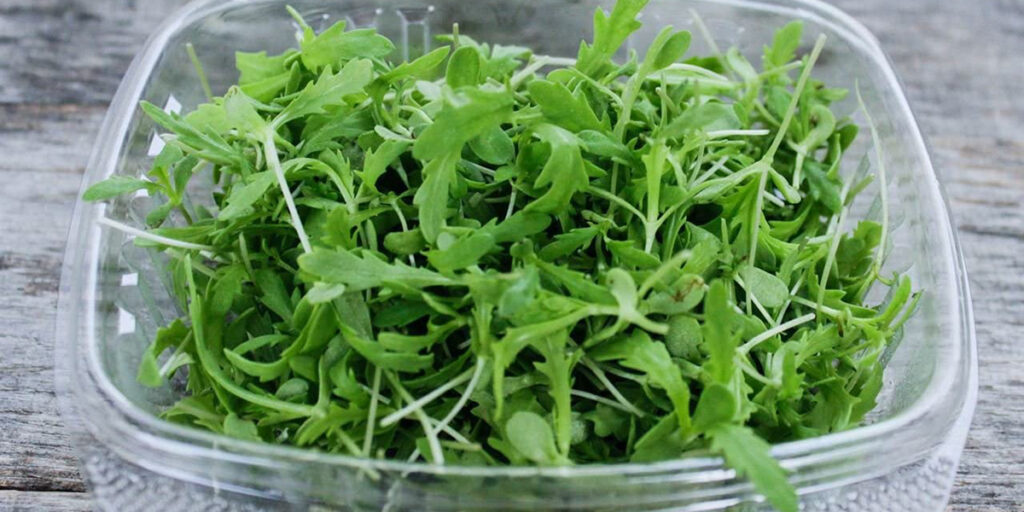
Another Asian microgreen with a delightful floral aroma and a slight bitterness. The edible chrysanthemum microgreens are short, with thin, serrated light green leaves. It is an excellent addition to salad mixes.
The golden-flowered crowned variety grows quite slowly, and it may take 2 to 3 weeks before harvest. It can be grown as an edible flower or salad greens.
Edible chrysanthemum microgreens contain vitamins A, C, E, K, B12, and B6. Young Kikubari shoots help maintain a healthy metabolism, improve vision, strengthen the immune system, and reduce the risk of blood clots.
| Taste | Carrot-like, earthy with a floral aroma |
| Color | Light green leaves and yellowish-white stems |
| Pre-soaking | No |
| Germination time | 3-5 days |
| Harvest time | 12-18 days |
Sorrel
Tender leaves with a sour taste reminiscent of lemon. It excellently revitalizes the body. Perfectly pairs with egg dishes, cheese, salads, and sauces. Additionally, you can wait a bit longer to grow it into a salad for making vegetable patties or sauces.
Sorrel is easy to grow since seeds do not need to be pre-soaked; just spray the seedlings several times a day to maintain moisture in the substrate. Seedlings will sprout in 1-2 days, and for better growth, they will need additional light after 3 days.
The microgreens are rich in minerals and vitamins. Sorrel contains oxalic acid and various carotenoids. They play an important role in skin health, heart health, lowering blood pressure, strengthening the immune system, and regulating body functions.
| Taste | Lemon-like and slightly sharp |
| Color | Bright green leaves and stems |
| Pre-soaking | No/Yes (4-8 hours) |
| Germination time | 1-2 days |
| Harvest time | 3-6 days |
Spinach
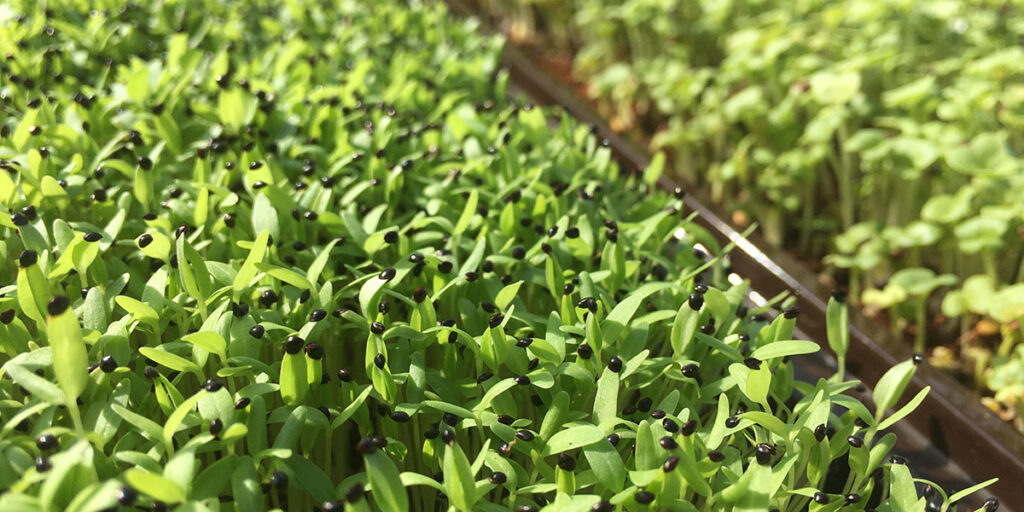
Spinach microgreens are very tasty and have a mild (slightly sweet) flavor. Microgreens with a delicate taste and spicy aroma. A good addition to vegetable side dishes, salads, and meat sauces. Spinach sprouts and grows quickly and has good cold resistance.
Spinach has been associated with health benefits such as reducing the risk of cancer and improving eye health (thanks to the compound lutein). It contains fats, proteins, iron, and vitamins. It normalizes blood circulation, lowers cholesterol levels, and removes toxins from the body.
| Taste | Mild spinach flavor |
| Color | Bright green leaves, pale green or red stems |
| Pre-soaking | No/Yes (4-8 hours) |
| Germination time | 1-2 days |
| Harvest time | 3-6 days |
Sunflower
Crispy and juicy microgreens with the taste of sunflower seeds’ milk. Therefore, it is an excellent choice for almost any salad mix. Even children like sunflower microgreens. Served with meat and vegetable dishes.
Seedlings can be grown both in a hydroponic medium and in soil. You can also soak the seeds in a jar for 2-8 hours and then transfer them to soil after germination.
If you use raw hulled seeds, be sure to disinfect them thoroughly and rinse several times. This is necessary to prevent and reduce mold formation. Keep the sprouts in the dark if you want them to grow taller before they are exposed to light.
Sunflower is very beneficial, as it contains iodine, phosphorus, magnesium, calcium, and zinc, as well as vitamins E and K and folic acid. It helps combat joint pain and is useful for normalizing acid-base balance.
| Taste | Young nutty flavor |
| Color | Thick green leaves and yellowish-white stems |
| Pre-soaking | Yes (2-8 hours) |
| Germination time | 1-2 days |
| Harvest time | 8-10 days |
Tarragon (Estragon)
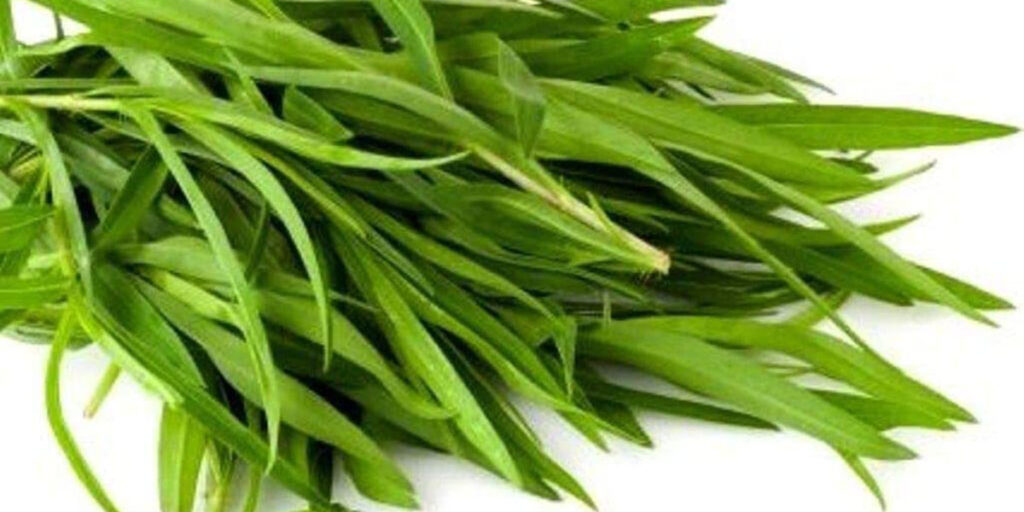
An aromatic plant from the Aster family, which has a unique flavor and is perfect for garnishing various dishes. Additionally, tarragon has a taste similar to anise and licorice.
Tarragon microgreens are delicate and excellent for fish and poultry dishes. They can also be added to cold soups to give extra freshness.
Tarragon contains various nutrients and essential oils that can provide many benefits: pain relief, improved sleep, women’s reproductive health, intestinal function, and cardiovascular health.
| Taste | Sweet, fresh, licorice flavor |
| Color | Bright green leaves, pale green stems with a purple tint |
| Pre-soaking | No |
| Germination time | 3-7 days |
| Harvest time | 10-14 days |
Thyme
Thyme microgreens are widely known as a medicinal remedy. They are also extensively used in cooking. Thyme seeds are small, they germinate and grow slowly, so it is recommended to soak them before sowing. After sowing, they should be exposed to light no earlier than 5-8 days later.
Young thyme shoots contain vitamins C, A, and B6, fiber, manganese, zinc, calcium, iron, and copper. They are best suited for raw dishes, as their delicate texture and aroma do not withstand high temperatures. Thyme can be added to dishes from various cuisines, pizza, spaghetti, eggs, soups, sauces, stews, or used to flavor marinades for meat.
| Taste | Herbal, spicy, slightly sharp |
| Color | Bright green leaves and light green stems |
| Pre-soaking | No |
| Germination time | 8-20 days |
| Harvest time | 25-35 days |
Turnip
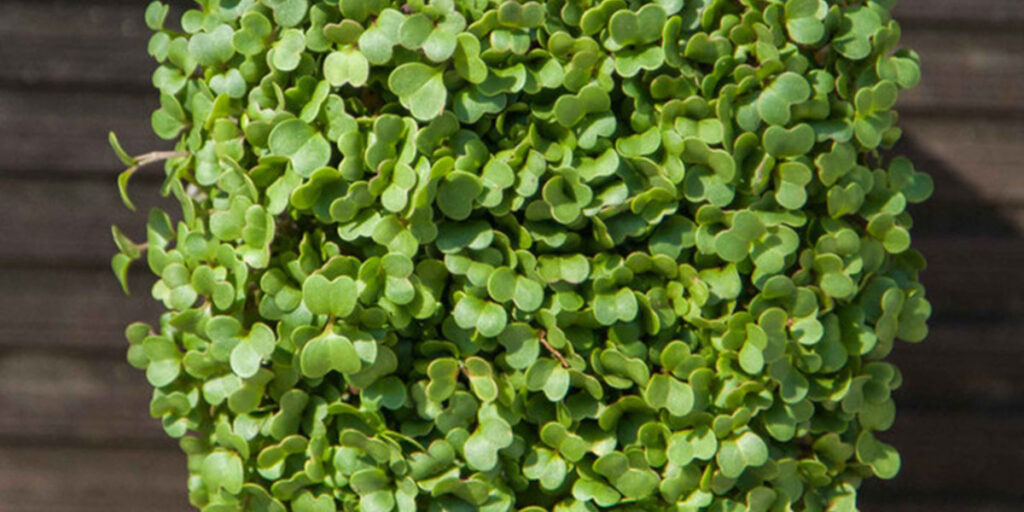
Turnip is a root vegetable from the Brassica family, whose microgreens have a sharp taste. Its sprouts are an excellent choice for salads and sandwiches. Additionally, turnip microgreens are easy to grow and do not require bright lighting. Turnip grows well both in soil and hydroponic systems.
Turnip microgreens are a source of vitamins K, A, C, E, and B6, folic acid, copper, manganese, dietary fiber, calcium, potassium, magnesium, iron, and phosphorus.
Turnip acts as an antioxidant, prevents retinal detachment, promotes bone health, aids weight loss, improves iron absorption, increases red blood cell production, and regulates cholesterol levels in the blood.
| Taste | Mild, sweet, and cabbage-like |
| Color | Bright green leaves, white and pink stems |
| Pre-soaking | No |
| Germination time | 2-3 days |
| Harvest time | 8-12 days |
Wasabi (Eutrema japonica)
Wasabi microgreens have a spicy and pungent flavor, similar to real mustard. Eutrema japonica is often used in many Asian dishes, added to soups and salads. Young wasabi sprouts are small with heart-shaped leaves.
When growing, keep in mind that eutrema grows in Asian countries where it prefers a warmer and more humid environment. Also, it should not be placed under direct sunlight but in a shaded area.
Microgreens are a source of protein and vitamins A, B6, and C. Wasabi has antibacterial and anti-inflammatory effects, promotes fat loss, and has anti-tumor properties. An excellent choice to add spiciness to salads and sandwiches.
| Taste | Spicy, sharp, mustard-like |
| Color | Bright green leaves, pale green or white stems |
| Pre-soaking | Yes |
| Germination time | 3-5 days |
| Harvest time | 14-21 days |
Wheat
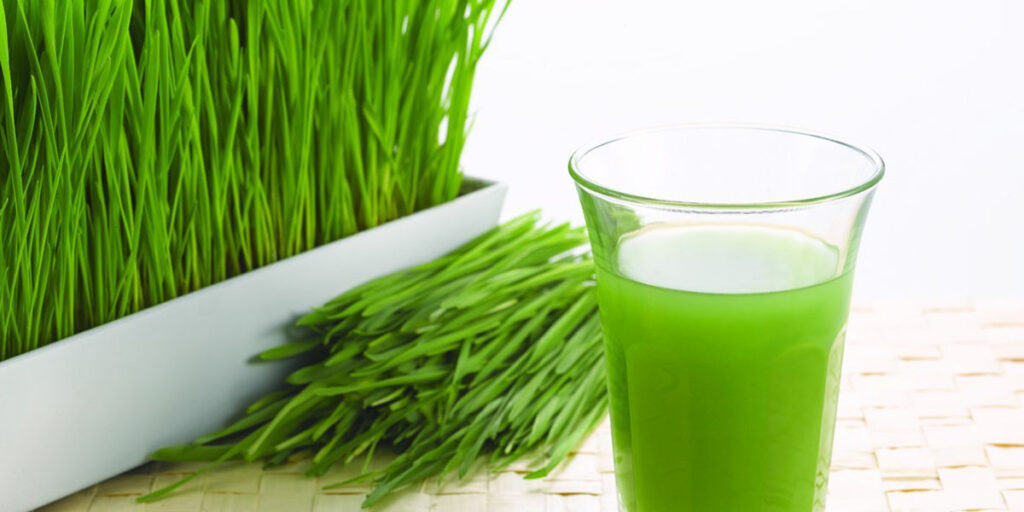
Wheat microgreens taste similar to barley but grow faster. It was previously used only as animal feed, but now, due to its health benefits, people have started consuming wheat microgreens as juice.
The tender sprouts have a grassy and slightly bitter taste. They contain many nutrients, including vitamins A, C, B, essential amino acids, and various minerals.
Consuming wheatgrass helps prevent cancer development, lowers cholesterol levels, improves digestion, slows aging, detoxifies the liver, and much more.
| Taste | Grassy, fresh, sweet |
| Color | Bright green leaves and stems |
| Pre-soaking | Yes (6-12 hours) |
| Germination time | 2-3 days |
| Harvest time | 7-12 days |
Red Cabbage
This variety contains several times more carotene and vitamin C than white cabbage. The sprouts are beneficial for digestion and help strengthen the immune system. They pair well with any salads.
Its tender red sprouts taste similar to cabbage itself. It is easy to grow and grows quickly, both in soil and hydroponic media. To increase yield, keep the seeds in the dark for the first 3 days.
| Taste | Cabbage-like with a slight bitterness |
| Color | Green leaves and light purple stems |
| Pre-soaking | No/Yes (6-12 hours) |
| Germination time | 3-5 days |
| Harvest time | 4-7 days |
Spelt (Triticum spelta)
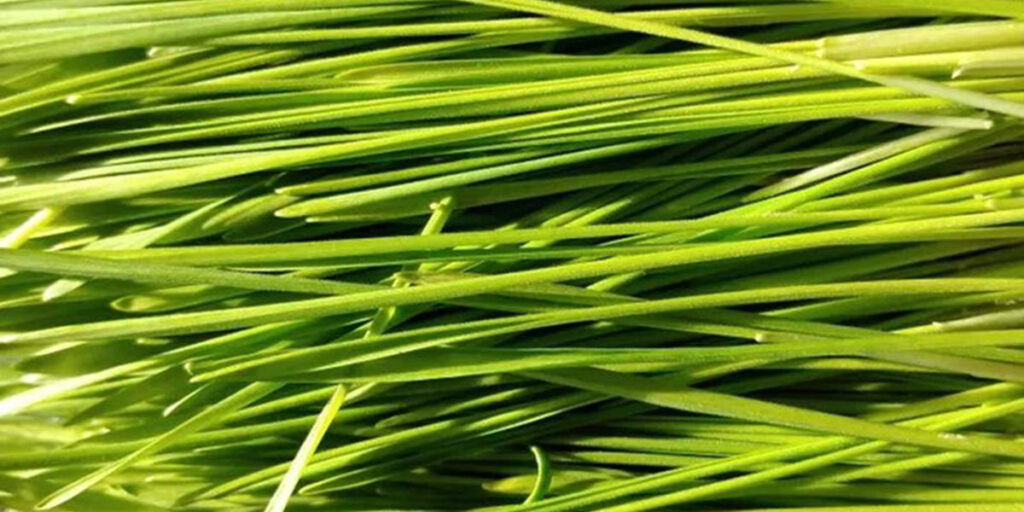
Another sweet and easy-to-grow grain. This plant has many health benefits, as it improves the function of the heart, blood vessels, digestion, immune system, and reproductive system. Spelt is now often recommended in healthy eating guidelines by leading nutritionists.
| Taste | Grassy, fresh |
| Color | Green leaves and stems |
| Pre-soaking | Yes (6-8 hours) |
| Germination time | 3-5 days |
| Harvest time | 7-10 days |
Milk Thistle
Another superfood that has yet to gain proper popularity. It can remove toxins and regenerate liver cells, protect against cancer development, control blood sugar levels, and lower cholesterol.
Milk thistle microgreens help prevent the formation of kidney and gallbladder stones, slow down aging, and improve brain function.
| Taste | Grassy, earthy |
| Color | Green leaves and white stems |
| Pre-soaking | Yes (8-12 hours) |
| Germination time | 1-2 days |
| Harvest time | 7-10 days |
Mustard
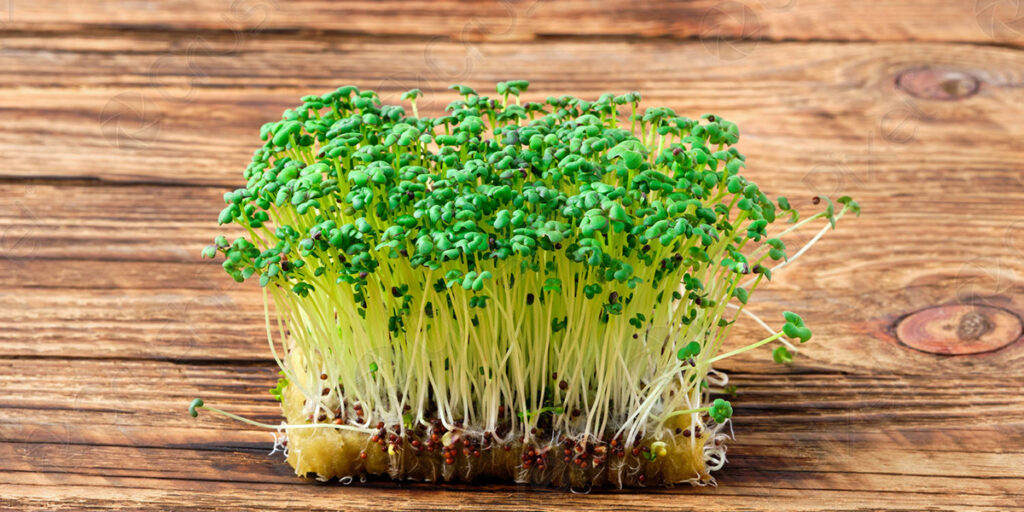
Mustard microgreens are grown from common (green) and red mustard. The greens have a spicy, sharp taste. They go well with fish dishes and salads. Mustard seeds sprout and grow quickly.
Mustard microgreens are rich in protein, fiber, folic acid, calcium, and iron. Mustard microgreens benefit vascular health, improve appetite and blood circulation. Mustard helps fight diabetes, stimulates healthy hair growth, relieves nasal congestion, and strengthens the immune system because it contains vitamin C.
| Taste | Mild mustard flavor |
| Color | Green or red leaves and white stems |
| Pre-soaking | Yes (8-12 hours) |
| Germination time | 4 days |
| Harvest time | 5-7 days |
Soybean
Soybean sprouts are a common ingredient in Asian dishes. They are popular not only because they are easy to grow, but also because sprouting significantly increases their nutritional value. This happens due to improved digestibility and quality of certain nutrients, such as proteins.
Sprouts are rich in vitamins C and B complex, and also contain much iron and amino acids. The complex of beneficial substances in soy has a calming effect on the body and normalizes cholesterol levels in the blood. Served with meat and side dishes.
| Taste | Asparagus flavor |
| Color | Pale green leaves and white stems |
| Pre-soaking | Yes (10-12 hours) |
| Germination time | 3-4 days |
| Harvest time | 10-14 days |
Oats
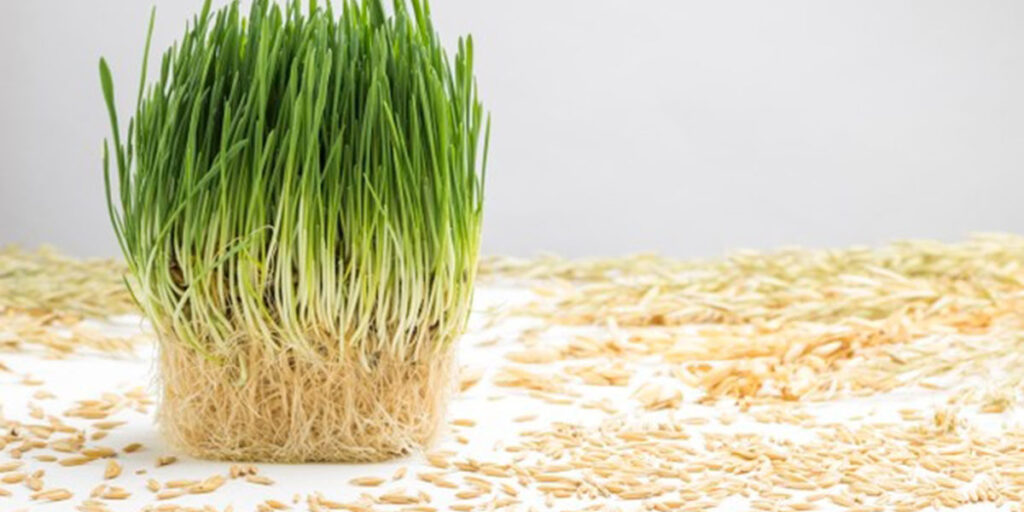
Oat sprouts are often grown for indoor cats or rabbits that do not leave the apartment. But few people know that oats are very beneficial for humans not only in the form of oatmeal but also as microgreens, as they contain a lot of nutrients for the body.
Oat microgreens are beneficial for the cardiovascular system, have anti-inflammatory properties, and due to their high fiber content, they positively affect the digestive tract. The sprouts are powerful immune stimulators and are useful for anemia, vitamin deficiency, and fatigue.
| Taste | Herbal, light taste |
| Color | Green leaves and stems |
| Pre-soaking | Yes (8-12 hours) |
| Germination time | 1-2 days |
| Harvest time | 7-9 days |
Parsnip
Green sprouts with a mild spicy taste, used as a seasoning for salads, soups, appetizers, and main dishes. They take quite a long time to germinate, so they need to be pre-soaked. After sowing, it is recommended to keep the seeds in the dark until they sprout.
Parsnip microgreens contain many essential oils, carotene, vitamin C, and carbohydrates. They help fight edema, improve blood circulation, and support the digestive system.
| Taste | Earthy, carrot-like |
| Color | Bright green leaves and shoots |
| Pre-soaking | Yes |
| Germination time | 5-7 days |
| Harvest time | 18-30 days |
Cumin
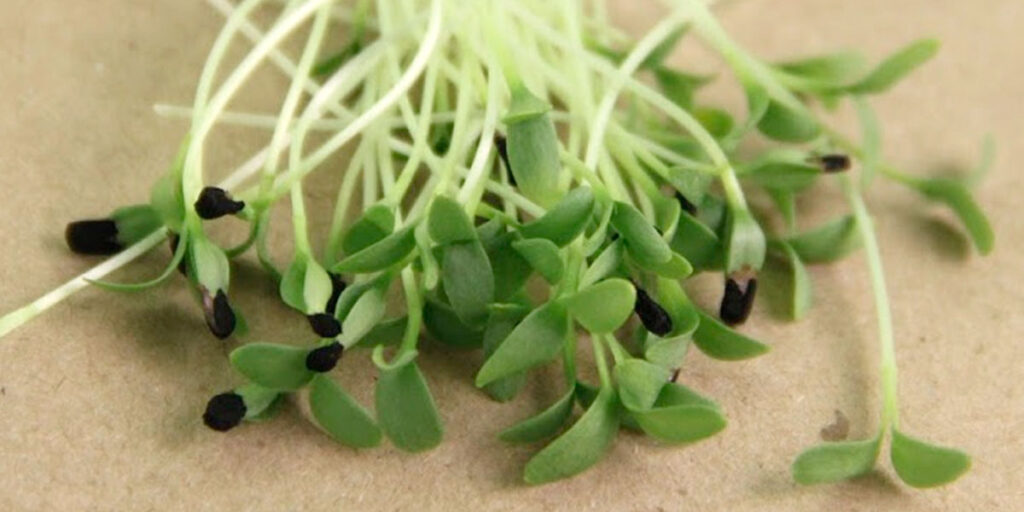
Sprouts with a spicy aroma and a sweet pleasant taste. They are used for garnishing dishes, as well as for making sauces, vinaigrettes, stews, and soups.
It is worth growing for people to improve digestion, aid weight loss, and support normal blood sugar levels.
| Taste | Spicy, sweetish |
| Color | Green leaves and light green and white stems |
| Pre-soaking | No |
| Germination time | 5-7 days |
| Harvest time | 10-15 days |
Turnip
Microgreens with a pleasant, slightly spicy taste. They serve as a great garnish for various side dishes, pasta, sauces, stews, and meat dishes.
Turnip microgreens are a valuable source of vitamins and strong health. They contain macro- and microelements (manganese, potassium, copper, iron, calcium, sodium, sulfur), fiber, and valuable amino acids (tryptophan, threonine, leucine, lysine).
| Taste | Fresh, slightly spicy |
| Color | Bright green leaves and white stems |
| Pre-soaking | Yes (4-6 hours) |
| Germination time | 3-5 days |
| Harvest time | 5-7 days |
White Cabbage
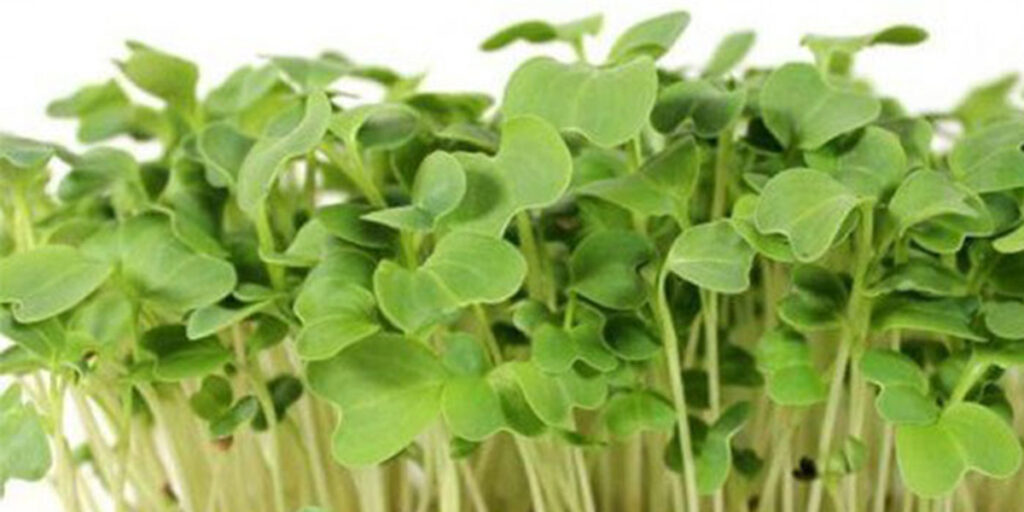
White cabbage microgreens are very juicy and tender. They perfectly complement salads, hot dishes, and cold appetizers. It is recommended to use fresh sprouts in food, as heat treatment reduces the content of beneficial substances.
Cabbage microgreens contain dietary fiber, organic acids, various macro- and microelements, as well as a wide range of vitamins (A, B, B2, B3, B6, B9, C, E, H, PP, U, beta-carotene).
Due to this composition, white cabbage microgreens help cleanse the body of toxins, regulate blood sugar levels, reduce cholesterol, aid in weight loss, positively affect digestion, and more.
| Taste | Delicate cabbage taste and aroma |
| Color | Light green leaves and white stems |
| Pre-soaking | No/Yes (6-12 hours) |
| Germination time | 3-5 days |
| Harvest time | 4-7 days |
Microgreens Harm
Microgreens are a very healthy product, but there are still some contraindications for their consumption. When choosing a crop to grow, it is necessary to consider personal intolerance or susceptibility to allergies to certain products. For example, parsley and spinach sprouts contain many essential oils and flavonoids, which may cause skin rashes in allergy sufferers.
For people with gastrointestinal problems, it is not recommended to eat plants that can cause bloating (peas, chickpeas, cabbage) or increase acidity (sorrel, onion, mustard).
Fortunately, there is a huge variety of crops grown as microgreens, and everyone can choose the plant that will bring them only benefits.
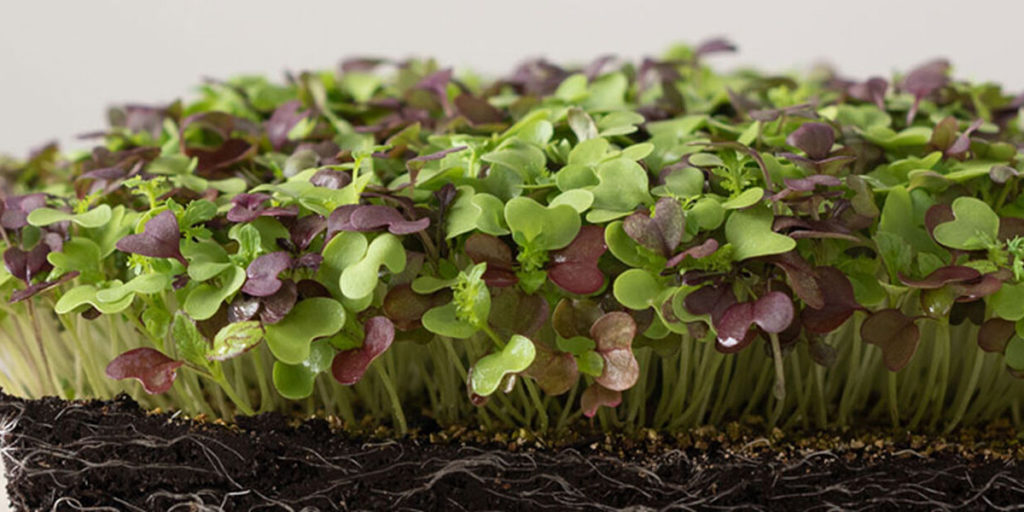
If you have found a spelling error, please, notify us by selecting that text and pressing Ctrl+Enter.

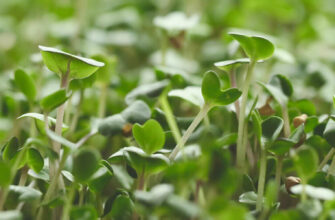
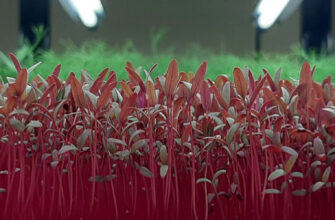
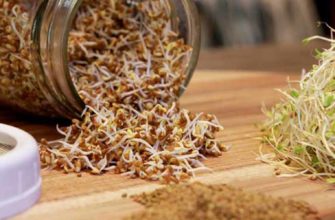
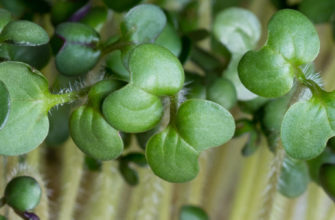

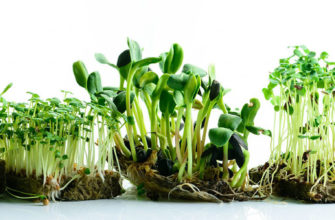
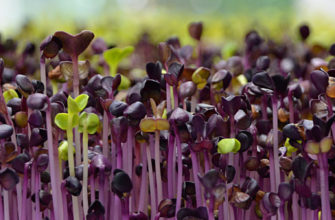
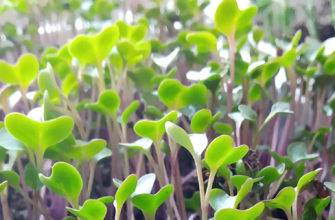
Excellent selection of microgreens, characteristics and methods of cultivation
Good day! Thank you for your positive feedback! We tried to provide as much information as possible on a given topic. We suggest you read other articles in the “microgreens”section.
Hello! Please tell me in your article it says about the microgreens of sesame and pumpkin, and in other sites no one recommends growing these crops or saying that they are generally harmful, where did you get this information so can you still eat them or not? Thanks
According to our information, white sesame is grown on microgreens pumpkin is also possible, it does not cause harm to people, but it is often written that there may be a bitter taste
Thank you very much! I found everything I was looking for!
Thank you for your feedback, please contact us!
Is it possible to grow burdock as a microgreen?
Unfortunately, we do not have such information
Burdock is milk thistle.
You didn’t write about rye. Can it be grown on microgreens?
Good afternoon! Rye microgrin is grown in the same way as wheat microgreens. It can be consumed fresh to remove toxins from the body and support the immune system. Sprouted rye seeds are also especially useful. It contains a large amount of iodine, which is usually deficient in many people.
Super! Everything is accessible and clearly described
Although I’ve been growing it for a long time for myself, I’ve learned a lot of new things today.
Thanks !
Thank you for your feedback!
Good afternoon! I’ve heard a lot about microgreens, but I haven’t grown them myself. After reading your article, I will definitely do it. But you need to consider that some plants can cause allergies.
That’s right, but the same can be said about ordinary crops, their fruits)
Good afternoon. Or is it possible to freeze or dry the cut microgrin ? If so, what is the shelf life in the freezer?
After defrosting and drying, it loses its marketable appearance, so we do not recommend doing this, given that you can grow it all year round.
I don’t understand anything. Some write that peas do not cause flatulence, others that they do.
flatulence is mainly caused directly by ready-made pea fruits, beans
Thank you very much Masha for this article! Lots of useful information. May you be lucky!
Thank you